Ultimate Roman Forum Map, Palatine Hill & Roman Forum Self Guided Tour
Complete guide to 37 attractions on palatine hill and the roman forum, self guided tour of palatine hill and forum romanum attractions, palatine hill and the roman forum.
Walking through the roman forum buildings and palatine hill ruins takes us back to a time when this small piece of land was the center of the Greatest Empire known to man namely the Roman Empire that spanned over 1,200 years . The nobility lived on palatine hill and displayed the power of the Roman Empire in the Roman Forum. For over 12 centuries, the roman soldiers and their leaders controlled vast lands from 700 BC to 500AD. For centuries the roman forum was the center of their day to day life, the site of religious ceremonies, triumphant processions, gladiator games and their commercial and economic center. You may have heard the term “all roads lead to Rome” meaning all roads led to this area of land that started as a marshy burial ground in the 7 th century BC and ended up after the fall of Rome as a cow pasture “Campo Vaccino” during the renaissance
In the 1,200 years since the start of the forum, the roman forum buildings have had name changes and function changes. The roman buildings have been destroyed in fires and riots, rebuilt, repurposed, dedicated and rededicated depending on who was out of favor at the time. Each roman forum building and site has its own colorful history which I will explain as simply as I can as roman history can be very complex

General Information
On a macro scale, the Forum and hills surrounding it were divided along functional lines. The Capitoline Hill was the administrative office. The Palatine Hill had the residences of nobility while the Forum at the base of the Capitoline hill was the place of political functions and commerce. The Forum square was also divided along functional lines. On one side you see the dedications to deities via temples, monuments, statues, triumphal arches as well as meeting places for governing and justice. On the other side of the forum you see roman buildings used for commerce; buying, selling and trade including market stalls
After purchasing our roman forum tickets which included two day passes to the colosseum , palatine hill and the roman forum, we started our roman forum tour from the colosseum and headed down the “via sacra” to the Arch of Titus entrance to the Roman Forum. This was the processional route of many religious and military triumphal marches/ceremonies
As you walk down this route, the historic significance is overwhelming when you think about the number of roman soldiers, golden chariots, kings, senators, emperors and other roman citizens who walked these very same streets for over a millennium
Self Guide Tour Map Palatine Hill and Roman Forum
Use the Palatine Hill & Roman Forum map & this self guided tour to visit the ruins. There are over 25 popular attractions; you can also download the google map of the ruins and use it offline as your self guided tour. It’s a good idea to do some planning before visiting the ruins because if you put yourself at the mercy of the tour guide, you may miss the fun of wandering around at your own pace and discovering the various attractions. We used an official tour guide and afterwards realized how much he didn’t cover. It would have been far better to have our own agenda in advance with a map (below) and attractions guide to visit the ruins
Download Interactive Palatine Hill a nd
Roman forum map to use online or offline.
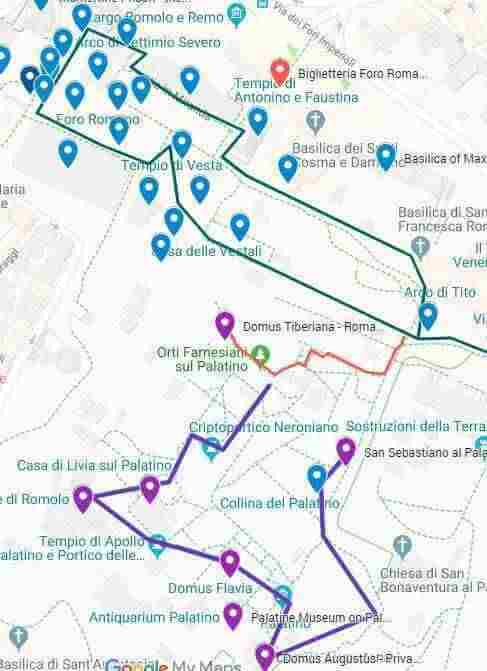
Download the Palatine Hill
Sacred road (via sacra).
Via Sacra is the main street in Rome from the colosseum to the top of Capitoline Hill (Temple of Jupiter Capitolinus). It is also the triumphal processional street from the colosseum to the Roman forum ‘
Many triumphal parades and religious festivals had passed along this route for many centuries. After the Great Fire of Rome in 64AD (attributed to Nero), Emperor Nero paved and lined this route with grand columns and replaced the butcher shops with high end stores at the forum romanum. He also straightened the road, removing the fork that led from the entrance of the forum to the north. Interestingly enough Via Sacra was also used by the prostitutes who lined the street. They mixed in with the Romans who went about their daily lives on the via sacra whether to attend to business at the basilica Aemelia or to visit one of the many shops that lined the street
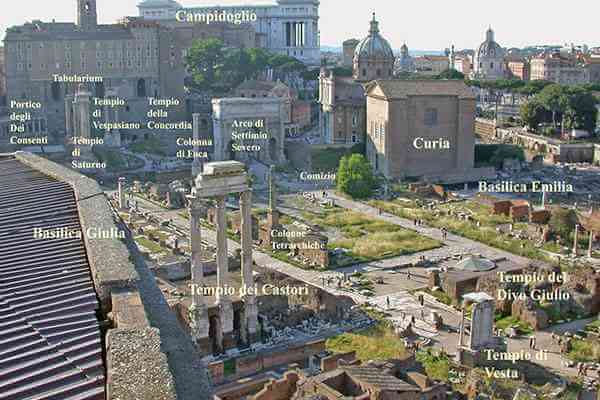
Arch of Titus (Arc de Titus)
The arch was built in 82AD by Emperor Dometian, to honor the Flavius family line , and to commemorate his older brother Titus and father Vespasian. Dometian was too young to take part in the military campaign, specifically referring to the victory related to the Siege of Jerusalem. One of the reliefs on the arch refer to this event and can be seen on the map that is associated with this self guided tour. Click on the Arch of Titus google map pin above to see the image of the relief.
The relief shows two key events from the battle: In one scene Romans are carrying the spoils of war including a menorah (a candelabrum used in Jewish worship) from Judea to Rome. In another scene you see the four horse chariot with the Emperor accompanied by deities and mystical figures in a triumphal march to Rome
Vespasian and his eldest son Titus were victorious over a revolt in the Roman province of Judea (Jerusalem). Many victories were celebrated with the building of a monument whether an arch or a column to remind the population of the triumphs of the Emperor
The arch is located at the base of Palatine Hill at a key location on the main triumphal processional route from the colosseum to the Forum Fomanum on the via Sacra
The inscription on the Arch refers to Titus and Vesparian as Divo Titus and Divo Vesparian. Divo meaning divine as they were deified after death. Whenever you see “Divo” on an inscription it means it was erected after death. The inscription is as follows:
“SENATUS POPOLUS QUE ROMANUS DIVO TITO DIVI VESPASIANI F VISPASIANO AUGUSTO”
Translated as “The Senate and People of Rome dedicate this to Divus Titus, son of Divus Vespasian, Vespasian Augustus”
Who built the Roman Colosseum
It was Emperor Vespasian who commissioned the Colosseum where Emperor Nero’s new place in the roman forum stood. His sons completed the Colosseum construction after Emperor Vespasian’s death. As a result the coliseum is also referred to as the Flavian Amphitheater, after the Flavian Dynasty to which Vespasian and his sons were part of
Octavian – First Emperor to be called Augustus – Emperor Augustus
Emperor Augustus (27 BCE – 14 BCE) was known as the greatest Roman Emperor. His birth name was Gaius Octavian and he was adopted by his great uncle Julius Caesar. The powerful Roman Senate bestowed the title of Augustus meaning “the illustrious one” and he was known as Gaius Julius Caesar Augustus. This did carry some resentment as Mark Anthony was recorded by Cicero as having said “You owe everything to your name”. Augustus was well liked and respected. He restored peace to the Roman empire and the economy, arts, and agriculture flourished under his rule.
Temple of Venus and Rome ( Temple de Venus et de Rome )
What I am about to describe are the many changes that have occurred to the Temple of Venus and Rome and the many name changes it has had over the centuries
The Temple of Venus and Rome is located on the Velian Hill, one of the original of the seven hill settlements that eventually became part of ancient Rome. Refer to image on the interactive map; the interactive map is found by clicking on the map image above. During the time when Roman worshiped idols, the Temple was designed by Emperor Hadrianin in 121 AD and finished by his successor the very popular and well liked Emperor Antoninus Pius in 141AD. (of the Antoninus and Faustina Temple in the Roman forum). Given the slope of the hill, the temple platform faced the colosseum and was 30 feet higher at the top of the hill
The Temple of Venus and Rome was ancient Rome’s biggest temple at 350 feet long and 150 feet wide, comprising of two main chambers where each chamber was dedicated to the goddess of Love and the Goddess of Rome. The temple was damaged in the first of many fires that ravaged Rome. After the fire in 307 AD, the temple was restored by the then Emperor Maxentrius
Emperor Constantine (ruled from 306 – 337AD) converted to Christianity and following his conversion signed the Edict of Milan in 313AD legalizing Christianity and allowing the freedom of worship. It also allowed Christians to build places of worship including St Peters Basilica . Christianity became the official religion of the Roman Empire in 380 AD under Emperor Theodosius I. Many temples and pagan ritual sites were abandoned, including the Temple of Venus and Rome. Emperor Theodosius I also suppressed pagan worship in 390AD, which started the movement to either convert the pagan worshiping temples to churches or to have them stripped to build other churches and monuments throughout Italy
In 625 AD, under Pope Honorius, and with consent of Emperor Heraclius, the abandoned Temple of Venus and Rome was stripped of its bronze and marble to repair Old St Peters Basilica. The next major event to take place to the temple (temple site) was the earthquake in the 9 th century (847AD). It damaged many buildings in the roman forum and virtually destroyed what was left of the temple
Santa Maria Nova (“New” Church)
The earthquake severely damaged the oldest church in the roman forum, the Santa Maria Antiqua. It was built in the 5 th century on the north-west slope of Palatine Hill which was an ancient hill known as Velien. Pope Leo IV ordered the building of the Santa Maria Nova Church (nova meaning new) on the site of the Temple of Venus and Rome
Santa Maria Nova Church, the “new” church was built to replace the Santa Maria Antiqua, as the place of worship. Once the Santa Maria Nova was built, the obligations and rights of the Santa Maria Antiqua was transferred to the Santa Maria Nova
In 1612, Santa Maria Nova Church underwent major restoration and was renamed Basilica di Santa Francesca Roman. It was rededicated to St Frances (1384-1440) who was born a noble woman. She dedicated her life to to helping the poor and was canonized in 1608. Her remans are still in the crypt in the church
Basilica of Maxentius (Basilique de Maxence et Constantin)
The site was the location of the Horrea Pipertataria warehouse which burned down in the fire of 283 AD. Horrea Pipertataria was built in the 2 nd century to store grain, clothing, marble, olive oil and other food items. When Emperor Septimius Severus (Same person who built the Septimius arch in the Roman Forum), died in 211 AD he had stockpiled enough food in the warehouse to feed the 1 million citizens of Rome for 7 years
The construction of the Basilica on the site of the warehouse began in 308AD under Emperor Maxentius and was completed under Emperor Constantine in 313AD. Constantine completed the basilica after he defeated Maxentius at the Battle of the Milvian Bridge in 312AD. A painting by Raphael showing this moment in history is on dispaly in Raphael Room 1 Hall Of Constantine titled The Battle of Milvian Bridge on the south wall. The basilica was nearly complete when Constantine took over the building and design thereby making minor changes. The changes included re-positioning the entrance from facing the Temple of Venus and Rome to facing Palatine hill to the South. He also added another apse, and replace the colossal statue of Maxentius located in the western apse with his own head
The Basilica’s originally functioned as a courthouse, administration building, meeting hall and a place of business, in essence a roofed extension of the forum. Over time the design of the basilica was used in the building of churches and basilicas and became synonymous with places of worship. Emperor Constantine felt that the design of the basilica, shaped like a crucifix, would be the perfect design for Christian worship. Many churches all over the world today are designed in the same way ie: in the shape of a crucifix
The Basilica of Maxentius and Constantine speaks to the engineering ingenuity of the Romans taking aspects of designs from the roman baths and of typical roman basilicas. Engineers today marvel at the technology that allowed the massive 130 feet high barrel and cross vaults to stand unsupported using unenforced concrete. It is a colossal structure of 6500 square feet and 66ft high. Of the Corinthian columns of marble that were built only one of the eighth has survived
Temple Of Divus Romulus (Temple de Romulus)
Originally it was the site of the temple of Jupitor Stator or Temple of Penates, identified by its rotunda. After the great fire in 306AD, Emperor Maxentius began a great rebuilding program in the roman forum. Maxentius and the Pagans were losing ground to the Christians which were estimated at 25% of the population. Maxentius who was trying to revive the old original pagan gods and temples, was killed by Constantine who eventually led in the era of Christianity.
Maxentius rebuilt this temple and dedicated it to his young son Valerius Romulus who died in 307AD. Romans believed that by building a temple dedicated to themselves, they became a deity (God). Emperor Constantine, after defeating Maxentius, renamed it back to its original name of Temple of Jupiter Stator
The temple was Christianized in 527 AD and the rectangular hall attached to the temple became the Basilica of Santi Cosma e Damiano (Basilica of Saints Cosmas and Damian). It was dedicated to twin brothers from Greece; Cosmas and Damian. They were both physicians, who were martyred and became saints. It is a functioning church today with an entrance from via dei Fori Imperiali
The most striking feature is the circular dome, with red porphyry columns surrounding the massive 4 th century bronze door. Legend has it that if a person is sick and sleeps in the Church, they would be cured by receiving a dream that would lead to a cure
In 1632, Pope Urban VII had the basilica restored. They raised the floor seven meters to match the current main level of the roman forum which had risen due to the pile-up of debris. It was further restored in 1947 adding a main entrance from the street and closing the one from the forum. Along with the Pantheon, it is one of the best preserved pagan temples in Rome
There is an additional charge to view the Temple of Romulus and is included as part of the SUPER ticket
Antoninus and Faustina Temple
By historical accounts, Emperor Antoninus and his wife Faustina had a happy marriage. They had two sons and two daughters. Faustina died at the age of 35. Antoninus was devastated by her death and sought to deify her. As a well-liked emperor he received the support of the senate and the temple was built in 141 AD dedicated to his deified wife Faustina the Elder. Emperor Antoninus established a charity dedicated to her called the Girls of Faustina whose goals were to assist orphan girls. Antoninus was the adoptive son of Emperor Hadrian and one of five “good” emperors of Rome. He reigned for 23 years, longer than any other Emperors other than Augustus. Like his father Hadrian, he disliked war and did not feel the need to expand Rome’s borders any further. His reign concentrated on making life better for those who lived within the empire. This resulted in the longest period of peace Rome had experienced. Historical accounts show him to be well spoken, a good orator, kind hearted, calm and not easily tempted by money and power. He exemplified what the romans wanted in an emperor. He died at the age of 74 in 161AD with such a high level of popularity that he was unanimously deified by the usually squabbling senate. The temple of Faustina was rededicated jointly to Antoninus and Faustina at the request of his successor Marcus Aurelius.
The temple was converted to a roman catholic church in the early seventh century and renamed Chiesa de San Lorenzo in Miranda. It is believed that this was the location of the sentencing of the St Lawrence by the Prefect of Rome. Over time its porch was enclosed with chapels. The notches in the upper part of the columns indicated the mark where the sloping tile roof of this structure was fitted into another ancient structure (they are not rope marks in an attempt to bring down the pillars as stated by various tour guides). The height of the door represents the ground level at the time the temple was built
House of the Vestals
Located behind the circular Temple of Vesta . It was the home of the Vestal Virgins, a female priesthood in Ancient Rome. There were six Vestals between 6 to 10 years old from noble roman families. They were in charge of carrying our numerous rites and rituals including keeping the eternal fire lit in the Temple of Vesta . The served for thirty years where the first 10 years they learnt the sacred rights, the next 10 years they performed these rights and the next 10 years they taught the next set of girls. The sacred rights included fetching holy water, keeping the eternal flame lit, guarding sacred objects, preparing sacrificial items, and other complicated ritualistic acts and ceremonies. During the thirty years served as vestal virgins they were forbidden from having any carnal relationships. At the end of their service, they were free to marry. No one was to harm them as they would be punishable by death and they were allowed to own property
They were watched over carefully by the Pontifex Maximus who had an adjoining house. If they failed to follow the chastity rules they were buried alive in a chamber below ground and their lovers were flogged to death. If they failed to perform their duties, like letting the lit fire go out, they were severely punished including being beaten with rods by the Pontifex Maximus. The rules became so stringent (no joking allowed) and the punishments so harsh that many parents were unwilling to offer their children to the task
The vestals lived together in the House of Vestas which was completely self-contained with a kitchen, a grain mill, an oven, baths, dining room, pools, a portico and courtyard complete with statues of featuring previous Vestals. After the great fire of 64AD, it was rebuilt by Nero. It underwent another restoration by Trajan and then again under Emperor Septimius Seversus. It shows the dedication to the cult over the years
After the suppression of pagan rituals by Theodosius in 390AD, the Vestals left in 394AD and the complex was used as imperial offices
Temple of Vesta (Tiempo di Vesta or Temple de Vesta)
It is located in the roman Forum near the House of Vestal Virgins. It is easily recognizable by its circular shape (refer to interactive map for image). Vesta temples were round and had east facing entrances to make a connection between the eternal fire and the Sun. The cult was started in 7 th century BC by Numa Pompilius, the legendary second King of Rome. The eternal fire represented the symbol of eternity of Rome and the romans believed that their fortunes were tied to the flame of the fire. As long the fire burned, Rome would dominate and extinguishing of the fire was viewed as a disaster for Rome
Like other buildings in Rome, the temple was built and rebuilt many times due to fires and earthquakes. The first destruction was in 390BC then again in 241BC, in 210 BC and during the time of Nero and Septimius Severus. It shows the romans dedication to the cult over the many centuries
The Temple remained mostly intact until the Renaissance when it was stripped of its marble and other assets. In 1549 AD it was stripped of the remaining marble to build palaces, monuments and churches throughout Italy. It was completely demolished at that time and only a few pillars and a partial base remain.
The debris from demolishing of the many buildings as well as earthquakes caused the roman forum to be buried over time
Temple of Caesar (Temple dei Divo Guilio, Temple de Caesar)
Julius Caesar was killed in 44BC on March 15 , commonly refer to as the “Ides of March”. He was stabbed 23 times by each of the 23 senators. The last stab wound was by his good friend and advisor Brutus. As the knife went into Caesar, he whispered “et tu Brute” translated as “you too, Brutus”. This is now a famous modern day phrase referring to betrayal
In Caesar’s will he had left 75 drachmas (1/3 of a soldiers annual pay) to every roman citizen living in the city. He left his private gardens to the citizens of Rome and named his successor as his adopted son and nephew Octavius. At his funeral, his general and loyal supporter Marcus Antonius (Mark Anthony) gave a speech at the Rostra. His eulogy inflamed the already heightened emotions of the roman people who now viewed Caesar as a deity
Julius Caesar’s Funeral
At Julius Caesars funeral, on the podium at the Rostra in the Roman Forum, Mark Anthony made his famous speech starting with “ Fr iends, Romans, countrymen, lend me your ear… “. In a dramatic fashion, Mark Anthony uncovered Caesars toga and lifting it at the end of his sword and waving it towards the crowds so they could see the gashes made by the 23 knife wounds. The crowds rioted, grabbed Caesar’s body and wanting to deify him, took the body to be buried with the other gods in the Temple of Jupiter on Capitoline Hill. They were turned away by the priest as people were not buried in temples. They returned to the forum with his body and cremated him in front of the Regia (palace of the Kings)
In 42 BC the construction of the Temple of Caesar began after the senate defied him and at that time Mark Anthony was named as the first priest of the temple. The construction took a long time and remained undedicated until 29BC. The site of the temple was the location of Julius Caesar’s cremation. In the years that ensued, there was a power struggle between Octavian (Julius Caesars named heir), and Brutus. Mark Anthony and Octavius combined forces to defeat Brutus’s army
Following Brutus’s defeat, there was a power struggle between Octavius and Mark Anthony, who had taken up with Cleopatra in Egypt. He was hoping to use Egypt’s wealth to launch an assault on Octavius. Their failed attempt led to the suicide of Mark Anthony and Cleopatra’s in 31BC. Octavian became one of Rome’s most beloved rulers and also its first emperor under the name Caesar Augustus
Augustus created a new roman tradition which was that dead roman rulers could be deified and as a god, they would have a temple dedicated to them. Julius Caesar was the first roman to be deified and honored with a temple named after him. The Temple of Caesar was dedicated to him on August 18, 29BC
Today the site of the Temple of Julius Caesar contains a mound of dirt that many leave flowers on. This was the altar of the temple and the actual site of his cremation
Shrine of Venus Cloacina (Sacrum Cloacina, Cloaca Maxima)
The roman forum started its life as a marshy burial ground for the settlements of the seven hilltops that surrounded this valley. Eventfully the settlements started to meet and trade. The marshy valley was seen as a perfects spot for a market to trade. They developed an ingenious sewage system called the Cloaca Maxima . It is one of the world’s earliest sewage systems. The shrine marks the entry to the system that drains the forum and it is marked by a shrine on unknown height and 8 meters in diameter thought to have been constructed in 33BC
Basilica Emilia
In 5 th century BC, the site was that of butcher shops called tabernae lanienae. In the 4 th century BC they were replaced by tabernae argentarie that is the city bankers or the center of banking. The building has undergone either damage or destructions due to fires, natural disasters and has been rebuilt in 210 BC, 191BC, 179BC, 14AD and 22AD. The 22AD restoration resulted in a basilica that catered to the courts, markets, shops and a place for public speaking. The latest rebuild resulted in a portico that overlooked the forum and was dedicated to the grandsons of Emperor Augustus; Gaius and Lucius (Porticus Gai et Luci). The basilica was almost completely destroyed by King Alaric and his Visigoth army in the Sack of Rome in 410 AD. It was rebuilt in 420 AD and finally collapsed in the 847 AD earthquake. The remains were used as building materials for monuments and churches elsewhere
Column of Phocas
The 44ft fluted column was dedicated to the Byzantine Emperor Phocas, Who had murdered his predecessor along with his five sons to seize the crown in 608 BC. The column of Phocas, located close to the Arch of Septimius is a rededicated column and the last addition to the roman forum. Originally dedicated to Emperor Diocletian, it was rededicated to Emperor Phocas in 608 BC. The original inscription at the base has been chiseled off and a new inscription praising lord Phocas as the perpetual emperor, crowned by God is still visible. The precise reason of this honor is unknown however it may have to do with Phocas’s donation of the Pantheon to the Church in the time of Pope Boniface IV. Most columns had a statue on top and this one was no different. The top of the column had a gilded statue of Phocas
Two years after the column was erected, Phocas suffered a heinous death in 610BC. His private parts were cutoff, he was skinned, beheaded and his body burned because he had raped a noble woman, identified as the wife of Photius, who was in service to God. Statues and monuments to him were then destroyed across the empire
Curia Julia
Curia was used to denote a place of meeting where an assembly or council discussed religious, official and public issues. Curia became synonymous with the meeting place of the senators. The powerful original House of the Senate was originally built by Emperor Tullus Hostilius, known as a warrior king. He was the third King of the 7 kings of Rome whose grandfather fought alongside the Romulus, the founder and first King of Rome
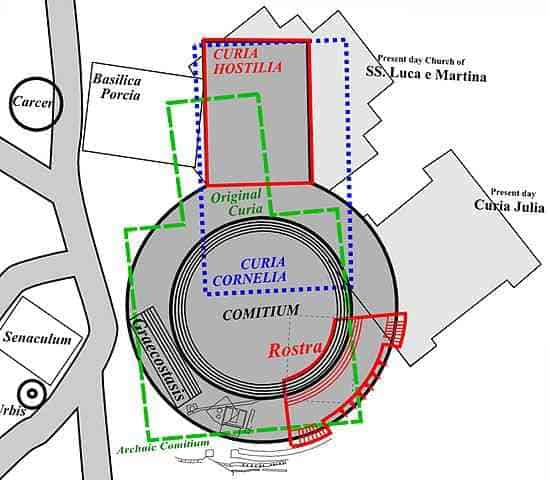
The Curia Hostilia began as a temple just next door to the current Curia Julia. The temple was the location were the warring tribes laid down their weapons during the reign of Romulus. The temple was used by senators as an indoor meeting place and a space was reserved outside for outdoor assembly. This space was called the comitium. The role of the senators was to act as council to the King. The temple was destroyed by fire and the Curia Hostilla was built next door to the original temple site. The site where the temple was, is the location of the present day Chiesa dei Santi Luca e Marti Church
In 80 BC, the dictator Lucius Cornelius Sulla enlarged the Curia Hostilius into the comitium space to accommodate additional senators. This new House of Senators was called Curia Cornius. Curia Cornius was burned down in the riots of 52BC. Curia Julia is the third name for the House of Senate. It was built in 44BC by Julius Caesar. During the construction phase the meeting place for the senate was relocated to Teatro di Pompeo (the theater), a temporary curia. He overhauled the curia design of both the House and the Comitium reducing the size of house and the number of senators (from 600 to 300). Caesar was assassinated by some of the senators before the curia was completed. His assassination was carried out by 23 senators (hence 23 stab wounds) who were worried about his thirst for power as he had also named himself dictator for life
Curia Julia was completed by his successor and nephew Octavius (Emperor Augustus Caesar) in 29BC. The structure has remained intact as it was converted into the Sant’Adriano al Foro in the 7 th century and further renovations were completed in the 1930’s
Lapis Niger
The Tomb of Romulus who was the founder and first King of Rome . The tomb is located in a prominent position in front of the Senate (Curia). It is covered with a black marble. The area is blocked off with a rope or railings. The oldest Latin inscriptions can be found on the column next to the tomb that suggests that a curse will befall anyone who walks on the site. You can see the Lapis Niger (large black marble slab) on one of the recreations of the roman forum self guided tour and map that accompanies this guide
The speakers’ platform, known as the Rostra was built directly at the base of the Constantine arch and next to the Lapis Niger
Chiesa dei Santi Luca e Martina (Eglise Saint Luc et Martine)
This was built on the site of the comitium, the meeting place of the roman senators. A portion of the comitium was replaced by the Curia Hostilia, the first house built specifically for the senators. This was replaced by the much larger Curia Cornelia in 80 BC which was demolished by Julius Caesar to build a much smaller Curia Julia in 44BC
Martina of Rome was from a noble family and was orphaned at an early age. She turned to Christianity and was persecuted by Emporer Alexander Severus as she defied his command to return to idol worshipping. She was subject to various forms of torture and was finally beheaded. She was martyred in 228AD. Pope Honorius I commissioned the construction of the church dedicated to St Martina in 625AD. It was restored in 1256 AD under Pope Alexander IV. It underwent another renovation in the 17 th century
Mamertine Prison – the Tullianum
It was built around 640 BC as a cistern (to hold water) for a spring. Sometime in the 4 th century BC, it became a prison. Above the spring were two floors; the lower level dome shaped dungeon called tullianum used for executions and the upper level used to hold prisoners awaiting trial. Prisoners were lowered into the dungeon (lower room) through a small round opening to die slowly. These were prisoners who were not executed publicly. Roman law did not have imprisonment as a sentence, therefore incarceration was a temporary measure for the sentence that was passed down at trial ie: hard labor, death, etc. The tullianium or jail was used as a holding cell for short periods
The apostles St Peter and St Paul are said to have been held prisoners here before their execution. An altar dedicated to them is located in the lower level of the building. It is said that the spring miraculously stated to flow when St Peter was held here and he was able to baptize his prison guards. The cross on the altar is upside down as Peter was crucified upside down. An Altar showing the event of St Peter baptizing his prison guards is located in St Peters Basilica , the site of St Peters Crucifixion . A painting by Raphael titled “Deliverance of St Peter” is in Raphael Room 2 Hall Of Heliodorus, north wall of the Vatican Museum. He was crucified in the Circus of Nero, Old St Peters Basilica was built on the Crucifixion site, his tomb is HERE in St Peters basilica
The site was converted into a Christian place of worship in the medieval times and today has a chapel on each level
- The Lower level – Capella San Peitro in Carcre (Chapel of St Peter in Prison)
- The Upper level – San Giusppe Dei Falegname
There is an additional fee to enter if you purchased the regular entrance to the forum, coliseum and palatine hill. You may need to book a time slot to enter
Septimius Severus Arch (Arc de Septime Severe, Arco di Settimio Severo)
The 23 m high and 25 meter wide arch was built in 203 AD to honor the Emperor Septimuis Seveus and his sons Geta and Caracalla. The reliefs in the arch portray the victories against the Parthians and other reliefs show romans capturing barbarians. The arch was topped with a gilded statue of Septimuis and his two sons riding in a chariot pulled by six horses. Unsurprisingly, given roman history, after Septimius’s death, Caracalla took over the throne and had his younger brother Geta killed in 212AD. He even had his name chiseled out from the dedication inscription of the arch and replaced with additional titles and dedications to Septimius and Caracalla
The Rostra (I Rostri, Rostra vetera)
The rostra is a platform measuring 24mx12m at the base of the Arch of Septimuis. It was built as a speaker’s platform where any citizen could address the crowds. It was from this platform that Mark Anthony address the Romans after Julius Caesar’s assassination in his famous speech starting with “Friends, Romans, countrymen, lend me your ears…”
Umbilicus Urbis
The Umbilicus Urbis is located close to the Arch of Septimuis. A small plaque on a circular brick structure with latin inscription is used to denote the location. It is the symbolic center of roma
Below this location is the Mundus, the gateway to the underworld of the dead. The pit was ritually opened three times a year. According to legend, when Romulus founded rome, he had a circular pit dug and the first fruit of harvest along with a handful of dirt from the citizens place of origin was thrown into this pit every year and the city of Rome was built around it
Milliarium Aureum
Translated as the “golden milestone” it was built in the time of Emperor Augustus Caesar (birth name is Octavian – the nephew of Julius Caesar) in 20BC. Used to measure distance, all locations in Rome Empire were measured relative to their distance from the golden milestone. “All roads lead to Rome” refers to this central spot of Rome’s road network
Temple of Vespasian and Titus
Upon the death of his father Vespasian, Emperor Titus started this temple to deify his father. He died before the temple was completed and his younger brother, Emperor Domitian completed the structure and dedicated it to both his father and his brother. The dual dedication raised the status of the Flavian family to which Domitian belonged. Domitian was also responsible for the construction of the colosseum or Flavain amphitheater
A central repository of official city documents from 78BC, the project was commissioned by the roman dictator Lucius Cornelius Sulla (from the Curia Cornelius era). The tabularium is a 74m long building located at the base of Capitoline Hill. It was the location of Rome’s official documents and offices of many city officials, the city hall and records office. The building housed the public state archives including important public acts of ancient Rome, the decrees of the Senate and peace treaties. Its laws and treaties were kept here on tablets. The tablets were engraved on bronze tabulae (hence the name of tabularium). You will not be able to enter as the building is closed to the public
Temple of Saturn (Templo de Saturno)
This site was the location of the Altar of Saturn. The altar was replaced by the Temple of Saturn which was dedicated to the agriculture god in 497BC. The order to build the temple was given by King Superbus, the last King of Rome before the start of the Roman Republic. At one time it held the public treasury which was beneath the stairs under the high podium. The temple underwent several restorations in 42BC and after a fire in 283AD. Very little else is known of its history. It is identified by the eight columns that are still left standing at the foot of Capitoline Hill on the western end of the roman forum
The worshipping of Saturn was celebrated on December 17 every year dating back to the 5 th century. It was a very popular celebration which included exchanging of gifts, slaves were given the same rights as other roman citizens and there was a general atmosphere of goodwill. The celebrations could last up to seven days. Over time this festival was rolled into the Christmas celebration
Basilica Julia (Basilica Giulia)
The land was part of the House Scipio Africanus, a great roman general known as the Scipio the Great. He eventually retired to the country after being disillusioned by the roman political system and led a quiet life before his death in 183BC. Tiberius Sempronius inherited this land through his wife, who was Scipio’s daughter. Sempronius was a popular roman political figure, who built the Basilica Sempronia, on this site in 169BC. In 54 BC Julius Caesar demolished the Basilica Sempronia to build the Basilica Julia at 101 meters long and 49 meters wide
The basilica Julia was completed by Augustus (Octavian) and dedicated to Julius Caesar in 46BC. It burned shortly after and was repaired and rededicated in 12 AD. It was the location of four civil courthouses in an open plan layout. Historical documents show the exasperation of senators as they pleaded their cases and were drowned out by others in the court rooms adjacent. Those with great oratory skills seemed to get the most applause and best audience, frustrating the other senators who had a hard time having their case heard above the adjacent court room applause and speeches
One of the court rooms held the Court of Hundred, which ruled over inheritance issues. One particular interesting issue is that of a woman whose 80 year old father disinherited her 11 days before his death in favor of his new wife. The daughter took the wife to court and won the lawsuit.
The Basilica was a favorite meeting place. Aside from the court rooms, it included shops, the portico showed floor etchings of checker or chess type boards. It was destroyed by fire in 283AD and rebuilt and destroyed again during the Visigoths Sack of Rome in 410AD and restore in 416AD. Part of the basilica was converted into a church in the 7 th or 8 th century
Temple of Castor and Pollux ( Il Tempio dei Dioscuri)
It is located next to the basilica Julia but only three pillars remain of the temple. Castor and Pollux were twin sons of Jupiter where Pollux was immortal and Castor was mortal. Originally built in 484 BC after the roman general and dictator Postumius defeated the Tarquin Kings who had ruled Rome. Legend has it that the twin brother Castor and Pollux helped the roman army defeat the king’s army and then were seen to have stopped at a watering hole for their horses at the Juturna Springs. The temple was built right next to the Juturna Springs fountain. Like other buildings in the Roman Forum, it underwent destruction and rebuilds over the centuries falling into decline staring in the 4 th century AD after pagan worship was discontinued
Santa Maria Antiqua (Ancient Church of St Mary)
It is located at the back of the Temple of Castor and Pollux, close to Basilica Julia at the base of Palatine Hill. The church was converted from an old guardhouse that was attached to a ramp and was most likely the entrance hall to the Ramp of Domitian. The ramp connected the imperial palace on palatine hill to the forum and allowed the emperor to move between the two in his chariot. It is still in its original form
After the 9 th century earthquake (847AD) it was buried, thereby sealing and preserving it, until it was discovered in the 20 th century. This preserved many of the original frescoes and both roman and Greek-byzantine artwork from the early middle ages. With a stunning interior brought to life by modern technology, one feels that they have gone back in time 1500 years as it’s so well preserved. A definite visit if you are in the roman forum. The church is not always open to the public due to ongoing excavation
There is an additional charge to view the Santa Maria Antiquaand is included as part of the SUPER ticket
Domitian’s imperial Ramp
It was built in the 1 st century BC connecting the roman forum to the imperial palace on palatine hill. The 200m long ramp was designed to allow the emperor to make a majestic entrance by chariot. Originally there were 7 ramps levels with six turns in between. Some ramps are above ground and others are below ground. Only 4 ramp levels have survived, the rest are thought to have been destroyed in the earthquake of 847AD. The reception hall of the ramp was converted into a church in the 6 th century ( Santa Maria Antiqua )
Lacus Juturnae ( Spring of Juturna)
The fountain is from the 2 nd century BC and is dedicated to the water nymph and goddess Juturna. It is located at the foot of Palatine Hill were Castor and Pollux stopped to water their horses before after the battle of Lake Regillus in 496BC. The spring was most likely a source of fresh water for Palatine Hill. On occasion, the spring was used by the Vestal Virgins for their religious ceremonies. The water at the Lacus Iuturnae was thought to have healing properties. The elderly and infirm would go to the spring with offerings in order to secure the assistance of Juturna in curing their illness. It was in use until the aqueduct was built in 312BC
Domus Tiberiana – Roman Forums
The official palace of Emperor’s Caligula and Nero on Palatine Hill. The ground was leveled to build a very long terrace and colossal walls. Most of it is still buried beneath Cardinal Alessandro Farnese’s Gardens of the 16 th century. Caligula linked the palace via a bridge to the Temple of Castor and Pollux. The bridge was disbanded after Caligula’s assassination. It was destroyed in Nero’s great fire of 64AD and he built another palace to replace this one, the Domus Aurea. The Domus Aurea, referred to as the Golden House, was hated by the Roman public and led to Nero’s downfall
Farnese Gardens (Orti Farnesiani sul Palatino Rome)
The first private gardens in Europe, they were the work of Cardinal Alessandro Farnese (Alessandro Farnese became Pope Paul III). He purchased a portion of the ruins of Domus Tiberiana on palatine hill in 1550 AD. He had it filled in and converted into a summer home with terraced botanical gardens that overlooked the roman forum. There are some remnants of the Farnese Gardens including ruins of fountains, pools and pavilions that attest to its beauty, however very little has survived. The Farnese family home was located in the Palazzo Farnese in Ancient Rome and the Villa Farnese in the Trastevere region, across the Tiber River.
Palace of Domitian (Flavian Palace or Domus Flavia or Domus Augustana) – Nero’s Palace on Palatine Hill
The Palace of Domitian was built on top of Neros Domus Transitoria palace located on Palatine Hill. It was Nero’s first palace . After the great fire of 64AD, he moved from this palace to the new palace in the Roman Forum. The new palace was hated by the people, it was eventually demolished to build the Roman Colosseum .
Nero is said to have caused the fire of 64AD so that he could build a new palace in the Roman Forum, which he did. However he blamed the Christians for the fire and as punishment he crucified St Peter on that lie. St Peters Basilica was built at the site of St. Peters crucifixion. Then using the ”newly created” space in the Roman Forum, Nero’s built his new palace and moved from his palace on Palatine Hill to the new palace in the Roman Forum. The Roman’s eventually realized what he had done and that led to his downfall. The new palace was demolished and/or repurposed and on that same site the colosseum was built. ( Map of Colosseum)
The Palace of Domitian, also called Domus Augustana , was built at the end of 1 st century BC overlooking Circus Maximus. The complex contained separate areas for business activities, personal life and outdoor gardens. Domus Augustana referred to the private area of the palace and Domus Flavia referred to the public area of the Flavian Palace
Flavian Palace Structure:
- The gardens or stadium was a large rectangular area with gardens and an area for performances, smaller events and foot races
- Domus Flavia is easily identified as it had three vaulted halls that faced the roman forum. Two of these halls were basilicas and one was a large reception hall. During this period basilicas were meeting places to conduct business and not as a place of worship
- Domus Augustana had a large pillar courtyard, a spacious outdoor dining room called a triclinium, and private rooms
The palace become the office residence of the subsequent emperors and remained virtually intact until the fall of the Western Roman Empire in 5 th century AD.
House of Livia on Palatine Hill
Home of Livia; she was the wife of Emperor Augustus (Octavian) and was also known as Julia Augustus. Livia and Augustus had houses side by side on Palatine hill. You could say her house of part of the Augustus palace. Livia also had a Villa in Pompeii, Villa dei Misteri , that was destroyed during the eruption. There is an additional charge to view the House of Livia and is included as part of the SUPER ticket; you will need to book a time slot to enter
Domus Augustus on Palatine Hill (House of Augustus)
Octavian (Emperor Augustus Caesar) bought the house from a famous orator Quintus Hortensius and moved his residence from the roman forum to palatine hill. He expanded the house in 36BC. His house should not be confused with the 92AD 8,600sqm palatial complex of Emperor Domitian on palatine hill called Domus Augustana and also known as Palace of Domitian. Octavian’s house was considered very modest for an emperor. It is said that he slept in the same bedroom for 40 years. He built an adjoining house for his wife Livia, called the House of Livia. On the site he built the Temple of Apollo Palatinus.
The rooms in the house are identified by the well preserved frescoes ie: the pine Festoon room (room 6) and the room of masks (room 5). The house was destroyed by a fire in 3AD. It was rebuilt and became a property of the state. A tour of the house reveals his bedroom, study, hallway and a variety of stunning frescoe. The house has additional significance as it is located close to the hut of Romulus, and on the site of the Lupercal. The lupercal is said to be the cave where the she-wolf nursed Romulus and his twin brother Remus until they were discovered by the shepherd Faustulus who then raised them
Hut of Romulus (Casa Romuli)
A single room mud and straw hut on palatine hill, this is said to have been the residence of King Romulus, the founder of Rome . It was used by the pagan priests to offer sacrifices. The hut has suffered the same fate as many buildings in the roman forum having been damaged by fire and storms however it was restored to its original state on these occasions
Palatine Museum on Palatine Hill
Many artifacts from the excavation of palatine hill are located here, these include statues, mosaics, frescoes, pottery and an informative video. There are washrooms located just outside the museum as well. Entry was included in the regular roman forum ticket and may now be part of the new SUPER ticket, which is an additional purchase
San Sebastiano al Palatino
A small 110×150 meters church on Palatine Hill dedicated to the 3 rd century Christian martyr Saint Sebastian. It is built on a previous pagan temple site, using the foundations of the temple to build the church. Saint Sebastian was killed during Emperor Diocletian’s persecution of Christians. He was tied to a post and shot with arrows, which did not kill him. Saint Sebastian was rescued and eventually bludgeoned to death in 288AD. He was known as the saint who protected people from the plague
Circus Maximus (Circo Massimo)
A largest entertainment venue of ancient Rome accommodating 150,000 spectators at one time. It was built in the Valley of Murcia between Palatine Hill and Aventine hill, the earliest seven hill settlements of Rome. The venue measured 621mx118m and was used for chariot races, religious festivals, celebratory feasts, public games, recitals, hunts and gladiator games. Eventually the gladiator games moved to the colosseum
Around the 6 th century AD, the circus fell into disrepair and its materials were used to build churches and palaces elsewhere; its monuments such as the two obelisks were moved to other sites in Rome. One of the obelisks is located at Pizza del Popolo and if you get a chance to visit the piazza when you are in Rome, you will see the obelisk. The area was prone to flooding, and without flood management it was buried under 6m of debris. Minimum excavations have been carried out and today the area is a park but you can still make out the outline of the area
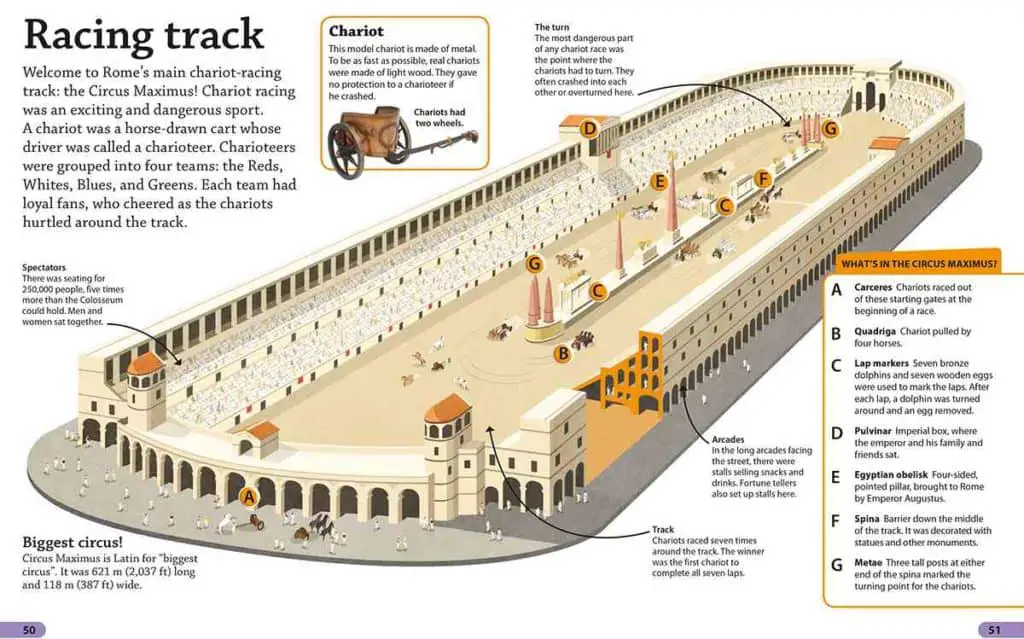
Other Attractions in Italy
- Visit the Roman Colosseum. Click on the Roman Colosseum attractions map HERE and accompanying Colosseum attractions guide HERE
- Take the Rome attractions map and self guided tour: It includes the Vatican City attractions map HERE and the Vatican attractions guide HERE
- Self Guided Walking tour to explore the neighborhood of Trastevere with map of attractions HERE and guide of attractions HERE
- Visit St Peters Basilica . Explore all the attractions in St Peter’s Basilica with the attractions guide HERE
- One of my favorite places is the Roman Forum and Palatine Hill . The map of attractions is HERE and the self guided walking tour is HERE
- Visit Pompeii with a complete self guided tour map HERE and the attractions guide to the 49 points of interest HERE
- Spend the day in Florence , this was by far one of my best day trips. The self guided walking tour map is HERE and the attractions guide is HERE
Related Posts

Flight delay compensation, claim up to €600 in cash
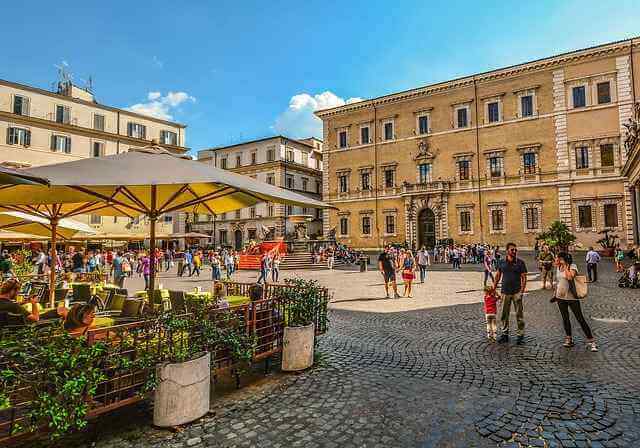
Delightful Trastevere, Self Guided Walking Tour of Trastevere Rome
This website uses cookies to improve your browsing experience and analyze the use of the website. Learn More

Roman Forum Walking Tour with Map

This post is a self-guided tour of the Forum in Rome as well as the adjacent Imperial Fori.
The tour should take approximately 1 hour or just a bit less than that. The walk is approximately 1 km (just over 1/2 a mile).
This walk is an abridged version of our Ancient Rome audio tour. Listen to a sample of the tour.
There is no schedule (take our tours anytime you wish). We also have an audio tour of Central Rome.
- Purchase this audio tour from our Booking Page (scroll down to Rome)($2.99/download).
- You’ll receive a confirmation email with a .pdf, Google Map link, and audio tour.
- Enjoy the tour(s).
There are also free guided walks that usually take place multiple times each day as well as tours that cover Central Rome, Vatican City, and the Colosseum.
Searching Availability...
The tour begins from Capitoline Hill ( map ). It is within walking distance of many historic Rome sites.
Click on the map to enlarge it or to download it to a smartphone.
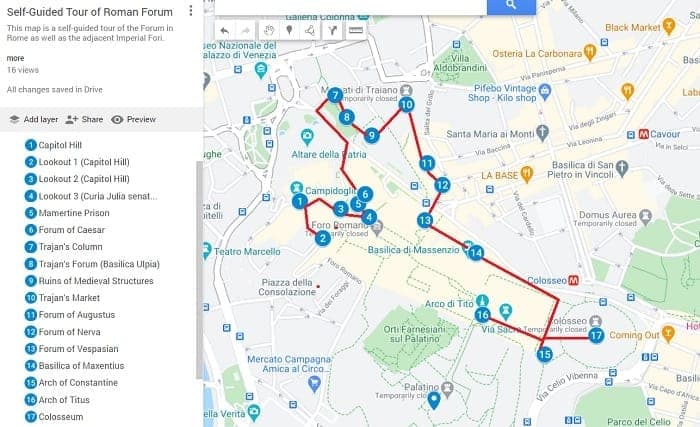
We have 4 other self-guided tours that we hope you will consider.
- Rome's City Centre
- Vatican City + St. Peter's Basilica
- Jewish Ghetto

Capitoline Hill/Piazza del Campidoglio
This location is filled with historic sites, including Piazza del Campidoglio itself, which was actually designed by Michelangelo.
Originally, this was one of the seven hills upon which Rome was built, and it was the center of civic life in the city for many years.

Today, the hill is home to many notable sites including the Palazzo dei Conservatori, the Palazzo Senatorio, the Capitoline Museums , and the Basilica di Santa Maria in Ara coeli.
There are also a few notable sculptures and fountains in the area, including Lupa Capitolina and Fontana della Dea Roma.
Overlook of the Roman Forum
You’ll find this overlook past Palazzo Senatorio, to the right, and past the arch on Via del Campidoglio.
This is one of the best places to get a good view of the Roman Forum, with several great examples of architecture that relied heavily upon the use of white marble and columns.
The Roman Forum was the first fora in this area, and during the era of the Republic, it was the only centre for civic life in Rome.
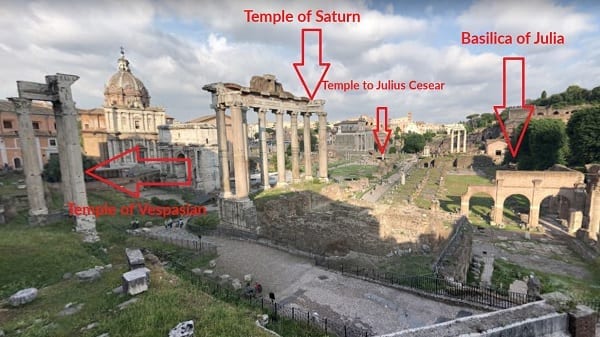
If you look directly ahead from the direction in which you came, you’ll see three columns that are remnants of the Temple of Castor and Pollux.
To the left of this site, you’ll find the Temple of Saturn represented by its eight remaining columns.
This was built shortly after the Temple of Jupiter, which makes it the second-oldest remaining temple from the Republic era.
You’ll find The Temple of Vespia right next to the Temple of Saturn.
Between the Temple of Saturn and the Temple of Castor and Pollux, you’ll also see the Temple of Antoninus and Faustina.
To the right of this site is the Temple of Julius Caesar.
Second Overlook of the Roman Forum
To reach this location from the last overlook, head back to Piazza del Campidoglio and turn right. D
Once you pass the palace, turn right again on Via di San Pietro in Carcere. The overlook is straight ahead and down the stairs.
On the far right, you’ll see the back of Palazzo Senatorio.
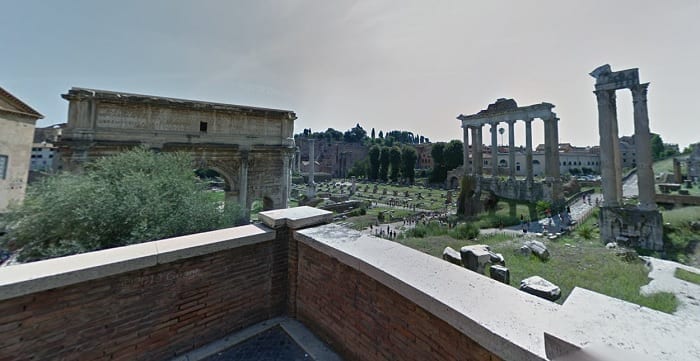
This part of the building was constructed over the old Temple of Veiovis, and it was used for the Tabularium (records office).
From the base of the wall here, you’ll see a few small ruins from the Temple of Concordia, a location that was once used for Senate meetings.
The irony is that Concordia was the goddess of harmony, and not every meeting which took place here was harmonious.

After all, this is where Cicero gave the last of many speeches that condemned a fellow senator’s plot to overthrow the Roman government, which resulted in his opponent receiving the death penalty.
On the left, you’ll see the remains of the Rostrum, a speaking platform that was used for public addresses.
You’ll find the Arch of Septimius Severus next to this landmark.
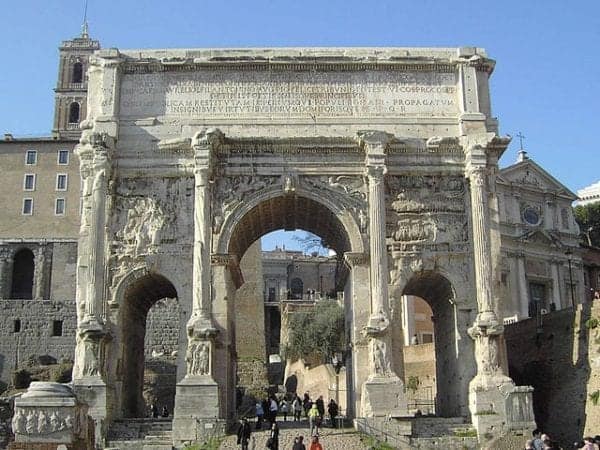
This is just one of many triumphal arches which commemorate the victories of famous Roman leaders, each part of a processional route used during Roman triumphs. We’ll be visiting a few more on this tour.
The next overlook is on the corner beside the Arch of Septimius Severus.

Overlook of Palatine Hill
If you look beyond the Roman Forum from here, you’ll see a hilltop in the distance, Palatine Hill.
This is the site where Romulus is said to have founded the city of Rome.
Archaeology indicates that three millennia of people have lived in this area, which makes it one of the oldest and most historic locations in all of Rome.
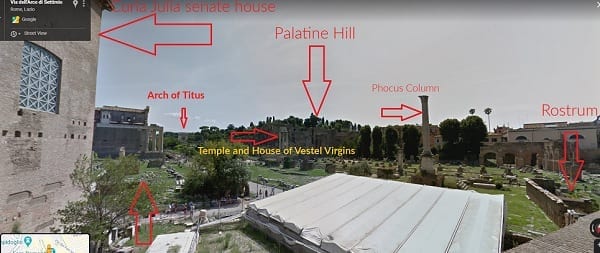
To give you a sense of just how much history is here, even ancient Romans would have looked at this location as a remnant of times that had long since passed.
In modern times, this is the site of both an outdoor and indoor museum that houses archaeological finds from the area. Tickets are included with admission to the Colosseum.
The buildings on Palatine Hill are surprisingly better preserved than those you’ve seen in the Roman Forum.
Mamertine Prison
Located just east of Piazza del Campidoglio, this historic site was once used as a prison, and it’s perhaps best known as the place where Vercingetorix was once held.
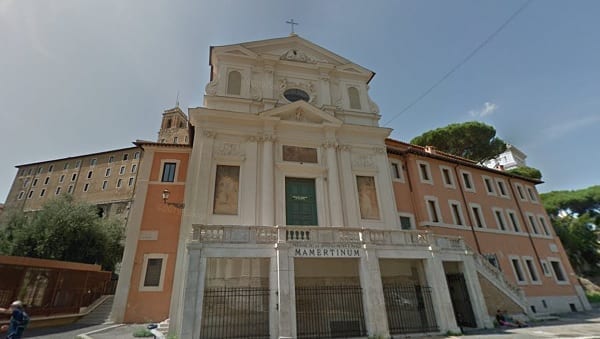
Although most prisoners here were given swift punishment, Vercingetorix underwent a sentence that lasted many years as a result of the civil war following Caesar’s return to Rome.
It is also said that Christian saints Peter and Paul may have been held here, and there is an inscription describing them above the word “Mamertinum.”
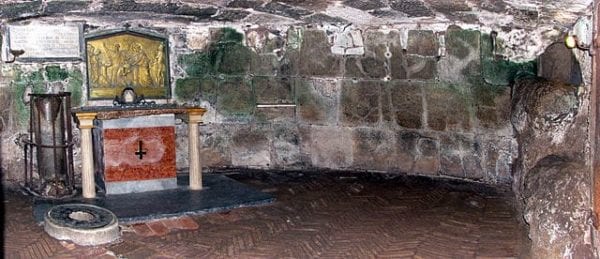
Today, there is an altar to Peter and Paul in this former prison.
Forum of Caesar
As the name implies, this forum was designed by Julius Caesar, and it was just one of many things he designed in the Roman Forum.
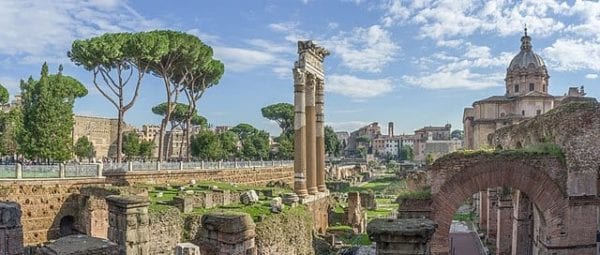
View of the Forum of Ceasar looking toward the Colosseum
The Forum of Caesar itself is a long, narrow, rectangular stone space that had previously been used for residential real estate.
Much like Roman Forum, this location was used to combine a bunch of different services that brought people together including a temple, shops, offices, and an open meeting place to talk.
This forum was intended to provide additional space for public activities, as the Roman Forum was becoming more crowded and the city needed more room for its growing population.
Trajan’s Column
Built in 113 CE, this column was named after Emperor Trajan, and it is dedicated to his victory in the war against the Dacians.
If you look closely, you can see depictions of the war engraved on this structure.
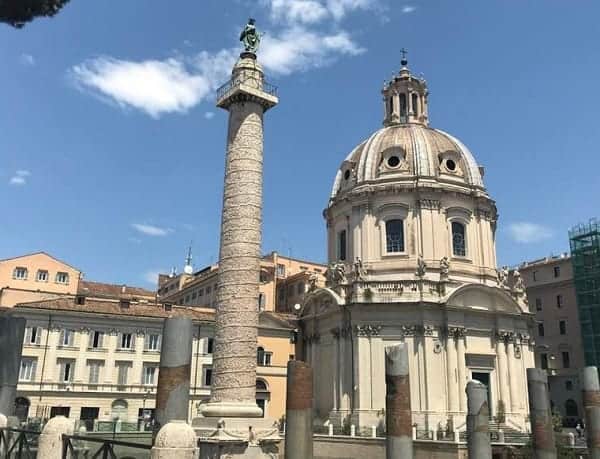
Trajan’s Column was built hollow with a spiral staircase leading to the top.
At almost 40 meters tall, this landmark is about as high as the hillside that they removed to make space for it!
Although the story of the war depicted along its walls is difficult to follow now as it spirals up the entire length, there were once two libraries flanking the column which had viewing platforms where you could see the engravings.
The statue on top was once of Emperor Trajan himself, but it was replaced with a statue of St. Peter many decades ago.
Forum of Trajan
The Trajan Column is just one small part of the greater Forum of Trajan which also contained the two libraries alongside the structure.
This location was also home to Basilica Ulpia, which was the largest church in Rome when it was built.
Just past the church is a 100-metre long public area with porticoes along its edges.
The entire area was given a marble floor and an equestrian statue of Trajan was placed in the center.
The excavation of this area isn’t as complete as other parts of the city.
But, it is thanks to Benito Mussolini that we can even see what we have today, as he was the mastermind behind the excavation of Trajan’s Forum.
Trajan’s Market
This marketplace was actually built into the hillside to keep it from falling, and it has been useful ever since it was originally constructed.
Over the years, Trajan’s Market was used to house both offices of government and commercial shops.
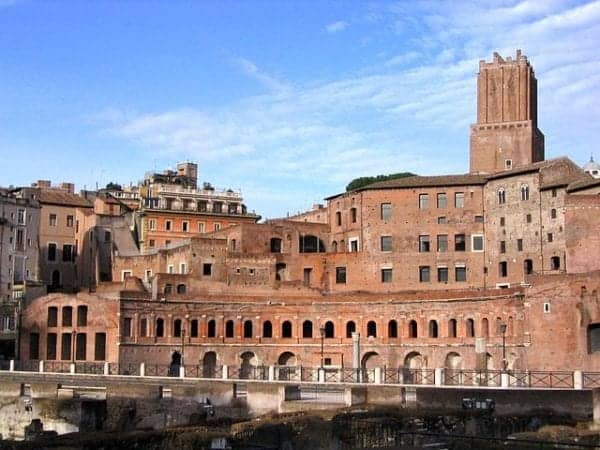
This may have been where ancient Romans picked up the government-supplied grain.
Due to the fact that it’s still in good shape, this is now the site of the Museum of the Imperial Fora, which is full of relics discovered during the excavation of all nearby forums.
Tickets to the museum are usually €11.50, but if they are hosting a special exhibit, you may have to pay €14 for admission which includes that attraction.
Forum of Augustus
When this location was originally designed, it included a colossus of Augustus and a Temple of Mars Ultor.
Pieces of both sites remain, but the artifacts from the colossus are now located at Trajan’s Market.
Sadly, much of this forum has been destroyed or built over, so there isn’t much to see here anymore.
That said, you can still see the back wall of the forum and three columns from its Temple of Mars Ultor.
Like all the other forums in the area, this location was used for civic functions and it was a public site where people could meet and conduct business.
Forum of Nerva
Named after Emperor Nerva, this forum was originally intended for his predecessor Domitian, but work on the structure was only completed after he left office, so Nerva ended up taking the credit.
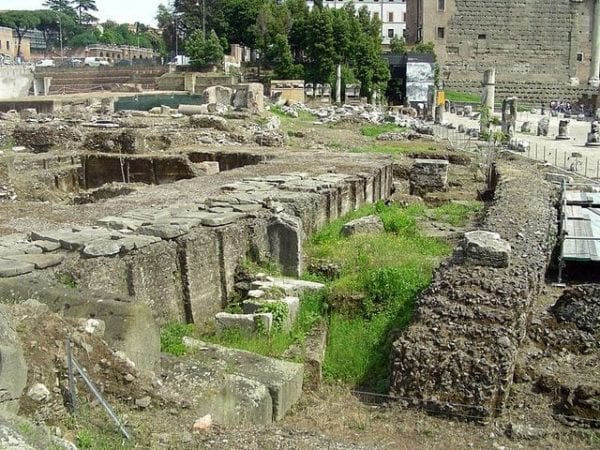
Although that might not seem fair, it’s perhaps fitting that this is one of the smaller forums in the area, and that’s because three other emperors already had similar sites built nearby before this one was finished.
Even though it’s technically known as the Forum of Nerva, Domitian’s influences can be seen here, as the temple in this area is devoted to Minerva -- Domitian’s protector goddess.
Since it was so narrow, this forum was used mostly as a road during the middle ages.
The newer road in this area covers most of the forum, preventing excavation teams from digging it up.
Forum of Vespasian/Temple of Peace
This entire site is actually the Temple of Peace, which was finished in 75 CE.
However, it has become known as the Forum of Vespasian over the years thanks to its enormous size which was similar to that of a forum.
Originally, the Temple of Peace was built to commemorate the victory of Titus and Vespasian in Judea.
Unlike an actual forum, the floor of this temple was earthen. However, there were long fountains along the sides of the courtyard which was bordered by rose gardens.
In addition to serving as a temple, this area was also used as a civic space with libraries, a medical school, and even a museum once found in the complex.
Today, the Temple of Peace houses parts of a huge marble map of the city as it existed in the early 200s CE.
Basilica of Maxentius
When this church was built, it took over the Basilica Ulpia as the largest basilica in all of Rome.
The full name of this location is actually the Basilica of Maxentius and Constantine.
These two emperors were once enemies on either side of a civil war, and they were two of the most important leaders of their time.
Constantine eventually beat Maxentius in 312 and finished the construction of this church, which was initially being built for Maxentius. As a result, the basilica is dedicated to both men.
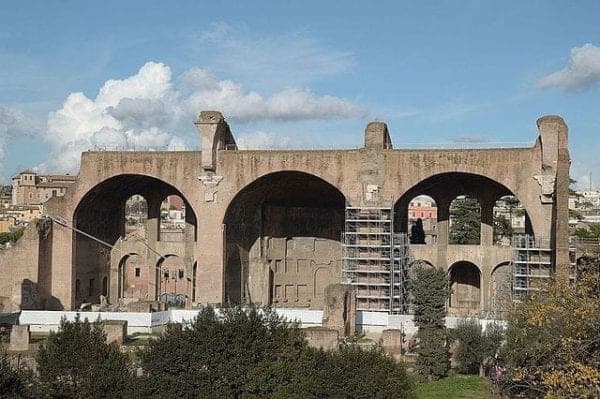
The Basilica of Maxentius and Constantine put the construction technology and knowledge of the Romans to the test.
Initially, it housed a colossus statue of Constantine, and there are a few pieces of this structure remaining in the Capitoline Museums.
Arch of Constantine
This arch commemorates Constantine’s victory over Maxentius in 312.
Although it was the largest of Rome’s triumphal arches, its statues and reliefs were taken mostly from other monuments in the city.

Both sides of the arch have statues made in the era of Trajan and medallions made in the era of Hadrian.
The reliefs do depict the events of his war with Maxentius, but the level of detail put into the artwork was nowhere near the same quality as you would expect from most earlier works in Rome.
Arch of Titus
Much like the Temple of Peace, this arch was also built to commemorate the victory of Titus and Vespasian in Judea.
The arch depicts scenes from this victory, including the theft of a menorah which would eventually be displayed in the Temple of Peace.
Unfortunately, the events depicted are also part of a long history of mistreatment of the Jewish people which resulted in the Diaspora.
For many centuries, Rome’s Jewish population would be subject to various taxes, forced to worship at Christian churches, and confined to the location known as the Jewish Ghetto.
If you’re interested in learning more about this area, consider taking out the Jewish Ghetto self-guided tour .
The Colosseum
Named after the colossus of Nero which once existed here, this location was originally known as the Flavian Amphitheatre, named after the Flavian dynasty of Vespasian, Titus, and Domitian.
This was the largest arena in the world at the time it was built, and it is one of the seven wonders of the world.
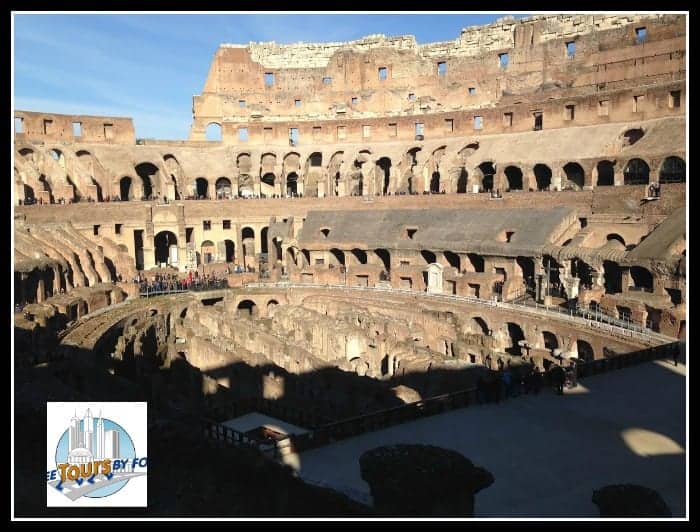
Although only a third of the original structure still remains, it’s still quite impressive to this day.
The Colosseum was used for multiple events including gladiatorial combat, naval battles, and more.
Today, you can purchase tickets to enter the Colosseum and get a good look at its interior. Tickets also include admission to the Roman Forum and Palatine Hill.
To learn more, check our post about visiting the Colosseum .
Choose a Destination... I want them all PLUS general travel tips. Amsterdam Berlin Boston Charleston Chicago Dubai Lisbon London Los Angeles Miami Nashville New York City New Orleans Paris Philadelphia Prague Rome San Francisco Washington DC
About The Author

Stephen Pickhardt
North america, united kingdom & ireland, middle east & india, asia & oceania.

Visiting the Roman Forum: all you need to know + best things to see and tips
All you need to know to plan a visit to the Roman Forum. Where to get the best tickets, the best things to see in the Roman Forum and the Palatine Hill, practical tips. Updated June 2021.
The Roman Forum is the heart of Ancient Rome and, nowadays, one of the most important archaeological sites in Rome and in the world.
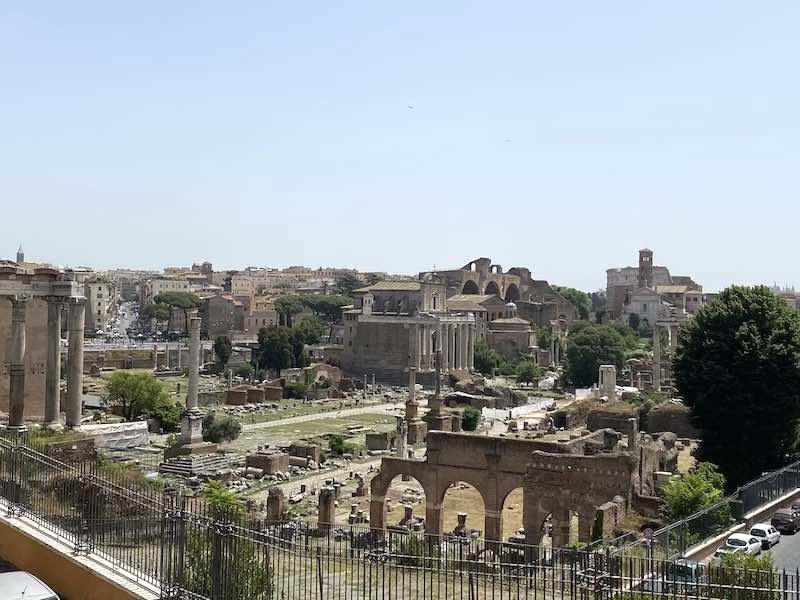
The ancient Rome Forum sits inside what is now the modern city and it is nestled between the Colosseum on one side, the Campidoglio Hill on the other, and the Palatine Hill, where the Palaces of the Emperors lie.
It is one of the most beautiful places in Rome however, it is also a place that attracts less attention than the nearby Colosseum.
While the Colosseum is on the bucket list of pretty much any Rome visitor, it is not unusual to find people wondering if the Roman Forum is worth visiting at all and I think the question is worth a proper answer.
While I believe the Roman Forum is stunning and a must-see for everybody I also believe that it is important to go there being prepared to what the forum is, what it isn’t, what to expect and how to tackle it at best.
This is my guide to visiting the Roman Forum.
Good to know . As well as being born and raised in Rome, I am a classics graduate and my dissertation was on Ancient Rome. So you can say I am biased when it comes to the Forum: I do love it! For the longest time, the Forum didn’t have good explanation panels and my recommendation was to get a guide to make the most of your visit. While I believe a guide is still worth it, the free app ‘Parco Colosseo’ now exists and operated almost as an audio guide. A good, budget-friendly option to see the Roman Forum!
Table of Contents
All you need to know to plan a visit to the Roman Forum
The Roman Forum is the area of Ancient Rome where public and religious life used to take place.
The Forum is now an archaeological site and, in a way, you can say that the Roman Forum is Ancient Rome.
Unlike the Colosseum or the Baths of Caracalla, that are two ancient stand-alone buildings, the Roman Forum is a large area where you literally walk along ancient Roman streets.
The area is large and mostly outdoors. Being prepared for the weather and for the uneven terrain is a must: I share all my tips on how to dress and what to bring to the Roman forum later in this guide.
The best things to see in the Roman Forum
The Roman Forum is a rather large area with plenty of things to see.
The Forum Proper is a flat area comprised between the Capitoline Hill and the Palatine Hill, the two most significant of the seven hills of Rome.
The Palatine Hill is immediately above the Forum and it is accessible though it. The Hill is where Romulus, Rome’s founder, set his hut and where the Emperors then built their palaces.
The best things to see in the Roman Forum are both on the Forum Proper and on the Palatine Hill. Let’s have a look at them.
Via Sacra is the Main Street crossing the Roman Forum.
Nowadays, you see is as connecting the Colosseum to the Capitoline Hill but it predates the Colosseum by many centuries.
The tradition reports that the Via Sacra was were Romulus won over Titus Tatius King of Sabina (VIII century BC) and while at the time the road was a little more than a muddy trail, this tells us some form of street here must have been in use from very early on.
The paving of the street as we see it now is made of slabs of basalt and seems to date from Augustan times (I century AD).
In historical times, the road was used for thriumphal procession after successful military campaigns.
The military parade would walk along this road with the prisoners and the flags of the enemy, bringing the victorious general in triumph all the way to the top of the Capitoline Hill, where the temple of Iuppiter Optimum Maximus (Jovis) used to be.
The Via Sacra is now one of the most scenic areas of the Roman Forum, especially close to the Colosseum, where tall columns are still standing, giving a sense of what this road must have looked like at its best.
The triumphal Arch of Titus
The first impressive monument you find on Via Sacra is the fantastic Arch of Titus.
The arch is one of the three triumphal arches in Rome and dates from the I century AD.
This is a celebratory monument build by order of Emperor Domitian, to honour his precedessot Titus.
As the inscription and carvings on the arch show, the arch commemorated Rome’s victory over Jerusalem and the taking to the temple, an event historians describe as happened in 70 AD.
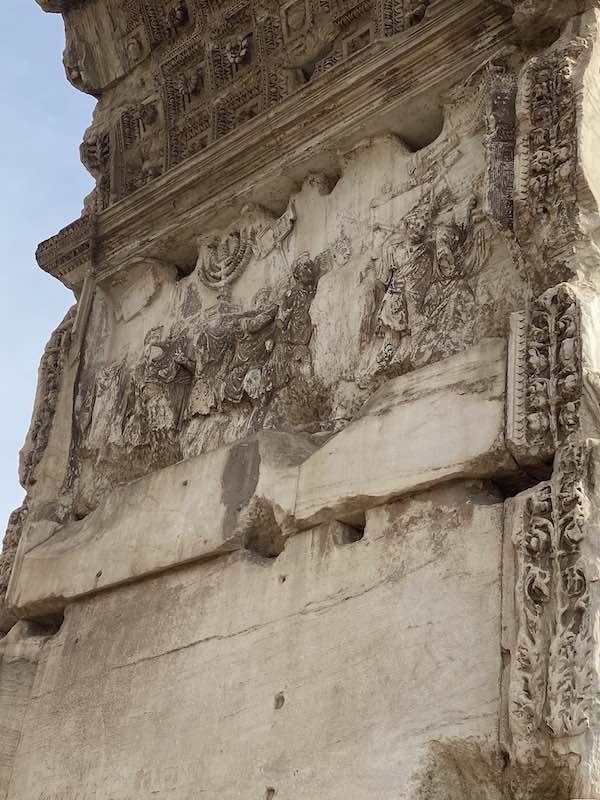
The Temple of Antoninus and Faustina
One of the most beautiful and best preserved buildings in the Roman Forum is the Temple of Antonino and Faustina.
The Temple sits on the spot where the Via Sacra meets the Forum and it was built in 141AD for Emperor Antoninus Pius and his wife: Faustina.
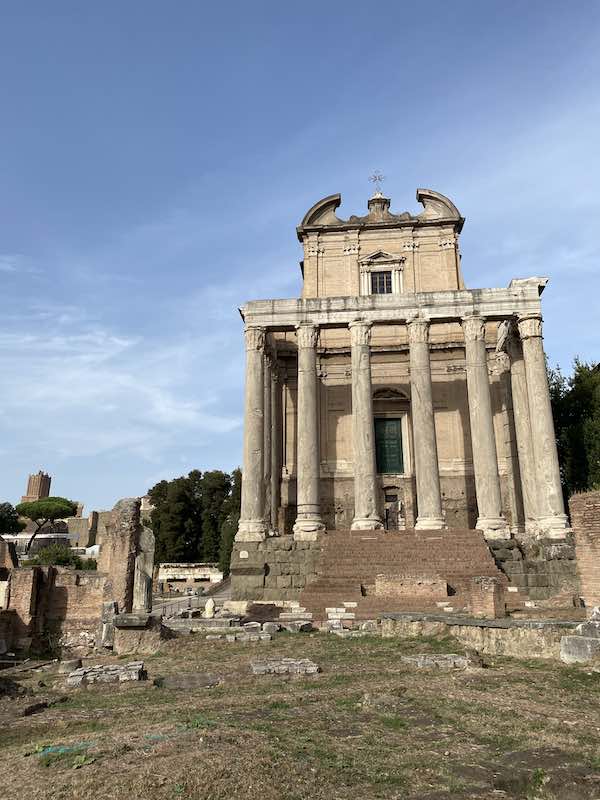
Like many ancient religious buildings, the temple became a a church in the Middle Ages and acquired the name of San Lorenzo in Miranda: this fate changed its appearance but it also ensures its preservation and allows us to enjoy it today.
An inscription at the top of the temple says ‘Divo Antonino et Divae Faustinae Ex. S.C.’ which means that the Senate dedicates this temple to the Emperor and his wife.
The temple stands on a podium with a height of 5 meters and is accessible by a recent staircase. This is one of the tallest buildings in the Roman Forum and one of the most eye-catching.
The Temple of Divus Romulus
The so called Temple of Divus Romulus is a round structure opening onto Via Sacra, inside the Forum.
It is not sure what the use of the temple originally was but we know it was built by Emperor Maxentius at the beginning of the IV century and was later incorporated into the church of Saint Cosma and Damiano, built here in the VI century by order of Pope Felix IV.
This temple is stunning and holds unique worth seeing. Please note that this temple is only accessible with the ‘Full Experience’ ticket.
The Roman Forum Square
The main square of the Roman Forum is a large area at the center of the Forum where all the most important business transactions and public events in the city would take place.
The area was an open unbuilt area for a long time but acquired an increasing number of public buildings and monuments, the latest of which is the column of Phocas, one of the most significant columns in Rome , dedicated in 608AD to the Eastern Roman Emperor Phocas.
Along the short sides of the square, there stood the platforms from where the orators would speak, the Imperial Rostra, the Rostra Vandalica and the Rostra ad Divi Iuli, dedicated by Augustus to Julius Caesar.
On the northern side of the square used to lay the Basilica Emilia: this was a civic area that used to serve as bankers’ headquarters and seems to date to the I century BC, yet the restored and modified many times in subsequent centuries.
On the southern side of the Roman Forum square there used to be another basilica, the basilica Iulia. This basilica seems to have been used for political, judiciary and economic activities and it takes its name from the person who commissioned its built: Julius Caesar.
Fun fact : here is where you can see remains of tabulae lusoriae , the ancient Roman equivalent to our board games! This is one of the best things to show children if you are visiting the Roman Forum with kids.
The Curia was the ancient seat of the Roman Senate. It is a large brick building wanted by Julius Caesar and inaugurated by Augustus, modified by Diocletian and finally turned into a church in 630 AD, fate that allowed the preservation of its beautiful Byzantine Frescoes and its stunning bronze door.
The Arch of Septimius Severus
The Arch of Septimius Severus is a large triumphal arch dating to the III century AD.
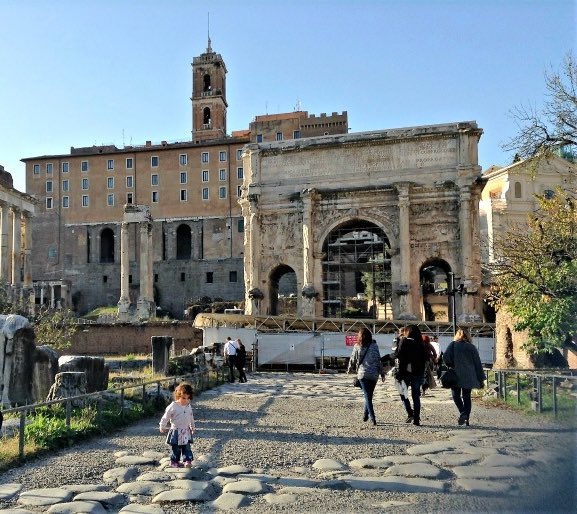
It sits at the end of Via Sacra, just below the slopes of the Capitoline Hill and it made of travertine, brickwork and marble.
The arch has the impressive size of 25×11.20×11 mt.
An inscription tells us that the arch was built to honour the Emperor and his son for ‘restoring the State and extending the empire of the Roman people’ and it used to have a bronze sculpture on top that would overlook the Forum.
Fun fact: in the Middle Ages, the arch became a fortress tower! It was restored only in the 1980s.
The House of the Vestals
The house of the Vestals is one of the prettiest areas in the Roman Forum.
It is one of the most ancient buildings in the city and it is usually associate with King Numa Pompilius, who established the Vestal Virgins as an institution.
The house got destroyed during the large fire of 64AD but was then rebuilt so we see now a later version of it. Still well visible are the rooms, the stairs to the upper floors and the portico, one of the most beautiful spots I the whole of the Forum.
The Temple of Vesta
The Temple of vesta is on the Eastern side of the Roman Forum and it easy to recognize thanks to its distinctive round shape.
The temple used to be part of the same complex as the house of Vestals, nearby. The temple was badly damaged however, ancient coins tell us the shape it would have had and restoration work from the 1930s patched up some of the fragments found in the area.
The Regia is said to be the place where King Numa Pompilius used to reside. This is one of the oldest sites in the Forum, with remains archaeologists were able to date back to the Iron Age.
The ancient necropolis
Between the temple of Antoninus and Faustina and the Temple of Romulus, archaeological excavations in the early 20th century brought to life and ancient necropolis (cemetery).
These graves date from the Latin Age (X century BC) and therefore predate almost anything else in the Forum. These are an important find for historians and archaeologist as they shed a light on a much more ancient use of this area that our ancient Roman sources do not cover.
The Farnese Gardens
If, from the Forum, you look up towards the Palatine Hill, you will see a structure that is clearly not ancient but rather from Renaissance Times, the ‘Farnese Gardens’.
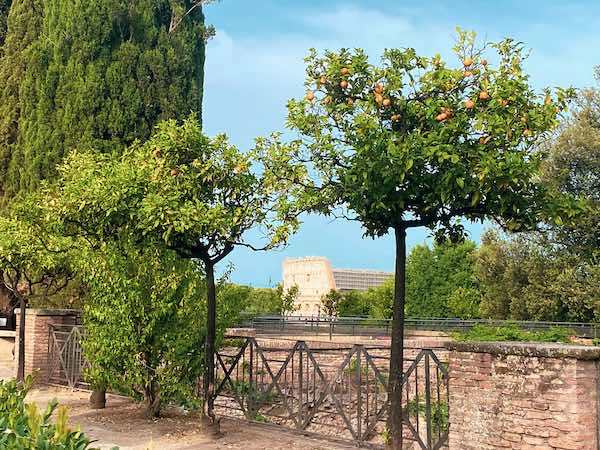
The Gardens were built in the early 1500s by Pope Paul III Farnese and quickly became among the most extraordinary gardens in the city for variety of plants and views.
The construction of the gardens took many years and their appearance changed in the XVII century, when two large aviaries where added, and then again up until the early 1930s.
What to see on the Palatine Hill
This is a quick overview of what you can see on the Palatine Hill as you climb up from the Roman Forum.
You can find here >>> our complete guide to the Palatine Hill for first time visitors .
The Palatine Hill is one of the ancient seven hills of Rome and the place Romulus fonder of Rome chose as the location for its new city.
The Palatine Hill is one of the most beautiful places in Ancient Rome and can be accessed from the Roman Forum, which it overlooks.
Things to see on the Palatine Hill are:
The huts of Romulus
The huts of Romulus are in the area of the Palatine called the Germalus, on the hill’s southwestern corner.
This is a group of dwellings that that seems to have been inhabited since the IX century BC and one of them is usually referred to as the ‘House of Romulus’, a full replica of which can be seen in the Palatine Museum.
This is a fantastic place to get acquainted with the very early days of the city of Rome.
The Palace of Emperors
In terms of visual effect, the most impressive sight on the Palatine Hill is the Palace of Emperor.
The Domus was built at the end of the I century AD by Emperor Domitian and it is divided into three parts: the Domus Flavia, with the rooms for business and entertaining guests, the Domus Augustana, the actual house of the Emperors, and the Stadium or Hippodrome, the palace garden.
The Palace is stunning to see: if you have time, I highly recommend you go to the Circus Maximus after your visit. It is just below the Palace, outside the archaeological park, but it offers outstanding views of the palace for the outside, the perfect complement to the sight you get from the Palatine.
The Palatine Museum
The Palatine Museum stands at the top of the Palatine Hill and hosts a collection of artefacts that spans over fifteen centuries of history of Rome, from its foundation to the highest successes of the Roman Empire. A must-see for history lovers.
The Roman Forum: frequently asked questions and need to know
What was the roman forum.
The Roman Forum was the administrative area of Ancient Rome.
It was the heart of the city, the place where religious, legal and political affairs took place and, as such, the beating heart of the political life in Rome.
Here, you would have had temples, some still visible, basilicas (a sort of meeting hall, at the time), religious buildings and of course streets and celebratory buildings such as the arches still standing at the two sides of the forum.
What is the Palatine Hill?
The Palatine Hill is one of the 7 hill of Rome and is usually mentioned with the Roman Forum is is just beside it and is accessible from the Forum itself.
The hill is historically significant and beautiful: here, you have the ruins of the palaces of Emperors, a museum, ongoing excavations and stunning views over Rome .
Is the Roman Forum beautiful? Is it worth seeing?
There is no doubt that the Roman Forum is a must-see place for anyone with an interest in Ancient Rome, but I believe the forum it is worth seeing also if you just want to see a beautiful place.
The area of the forum is simply stunning!
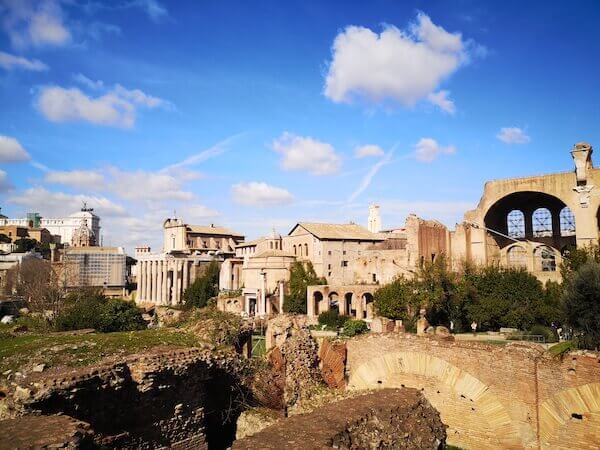
The Forum is now an open-air archaeological park and you can easily enjoy it even just as a place for a leisurely stroll.
If you go on a bright day, especially in the spring or the fall, the forum is simply breathtaking: you can easily walk to one side to the other in a matter of minutes and you can simply follow your curiosity picking and choosing the areas that attract you the most.
The most beautiful part of the Roman Forum is, for me, the walk up the Horti and the Palatine Hill. You will feel the steps in your legs but, once on top, you have the ruins of the palaces of emperors and views over Rome that are simply breathtaking!
The pine trees that are typical of the Rome landscape frame the Colosseum and the Forum below and give you a photo op like no other!
Is there a dress code for the Roman Forum?
There is no dress code for visiting the Roman Forum. Clothing rules such as no shorts or no strappy tops only apply to religious buildings and main basilicas such as St Peter but not to archaeological sites.
The only thing to keep in mind when visiting the Forum is practicality: good shoes are a must and weather appropriate clothing for the season of your visit will also be important.
You can find our tips on what to wear for the Roman Forum below.
How to visit the Roman forum: guided tour or self guided? 2021 Update
The Roman Forum is a place so full of history and thing to see it is best enjoyed with a guide.
The area has almost non existent info panels so without some form of guidance, you can enjoy its beauty but you won’t understand much.
The cheapest way to visit the Roman Forum is by getting standard tickets and downloading the Parco Colosseo app.
The app is free and has explanations in several languages about the main sights in the Roman Forum and on the Palatine Hill.
If you have a smart phone, this is an excellent option and it also has a recommended itinerary for kids and another one for the visually impaired.
If your budget allows, then I recommend you take one of the may Roman Forum tours available (see below)
How to get the best Roman forum tickets
You can buy tickets to the Roman Forum on the day or you can book them online here. If you do so, make sure you pick a solution that works for you: there are several combinations, offering access to different things.
The tickets include a visit to the Colosseum (all areas or just some parts depending on the ticket), the Roman Forum and the Palatine Hill, with the exception of some ‘super sites’ that you may need to book separatly.
Best Roman forum tours
Tours of the Roman Forum are bundled up with a visit to the Colosseum.
The best we have tried are:
- Priority Entrance to Colosseum, Forum and Palatine Hill with guide
- Colosseum (includes underground tier) and Roman Forum guided tour
- Walking tour of the Colosseum, Roman Forum and Palatine Hill (3 hours)
- Colosseum and Roman forum tour for kids (suitable for primary school kids too)
Need to know: the tours tend to give priority to a visit to the Colosseum, which usually takes up to 2/3 of the tour. If you are interested in a more specialized tour, then I recommend you get a private guide instead .
How long to visit the Roman Forum
It usually takes me between 2 and 3 hours to visit the Roman Forum and I would recommend to plan half a day if this is your first visit.
Technically, you can spend as little or as long as you wish here, however, I think within this time frame you can see some of the forum most impressive area, such as the temple of Antonino and Faustina, the House of the Vestals and the Horti and also the Palatine Hill.
What is the best time of day to visit the Roman Forum?
The best time of day to visit the Roman Forum depends on the season.
In spring and autumn, the best seasons to visit Rome, you can go pretty much any time of the day, with only one caveat: the late morning and lunch hours can get busy!
Aside from that, you don’t have particular constraints when it comes to weather and time of visit, in mid season. The situation changes if you are visiting in winter or summer.
In winter, the best time of the day to visit the Forum and the Palatine hill is the late morning / lunchtime.
The Forum and even more the Palatine can get really cold in winter and being there in the warmest hours of the day will go a long way to make you enjoy your visit.

Also, consider that in winter the Forum closes pretty early (about 4 pm) and darkness comes early too, so an earlier start is recommended.
In summer, it is the opposite!
The Roman Forum in summer gets scorching hot and must be avoided at lunchtime and in the hottest hours of the day at all costs.
The best time of day to visit the Roman Forum in summer is the early morning or the late afternoon (check the time of the last admission though, you want to make sure you have enough time).
What to wear to visit the Roman Forum
You do not need particular equipment to visit the Roman Forum, but it is worth knowing a couple of things:
The terrain in the Forum is uneven, so you are recommended to wear good walking shoes or sneakers: no heels. Find my recommended shoes for Rome sightseeing here.
There is very little shade in the forum so especially in the warmer season, it is important to wear a hat.
In winter, the Forum can get surprisingly cold and the Palatine Hill gets even colder: wrap up well and do go during the warmest hours of the day for the best experience or humidity may get to you and make your visit seriously unpleasant.
Is there food and facilities inside the Roman Forum?
The Roman Forum has some restrooms and drinking fountains but it is overall hardly equipped with food.
I highly recommend you take care of breakfast and lunch before you come: picnics are now allowed.
Is the Roman Forum accessible?
The Roman Forum is not entirely accessible but does have some defined paths for wheelchair users. You can find all the pupated information on the paths and lifts here
Visiting the Roman Forum with kids
We have brought the kids to the Roman Forum several times and it is always a good day out.
It is, however, a day that can pose some challenges, so it is good to be prepared.

These are the important things to know before visiting the Roman Forum with kids:
You can enter the Roman Forum with a stroller however, only part of the Forum is paved. If you can, I highly recommend you leave the stroller at home, especially if also visiting the Colosseum (find my tips for visiting the Colosseum with kids here).
Kids will be tempted to climb on top of the ruins but this is not allowed. There is however a good playground close to the Colosseum , which you can easily reach after your visit and works well as a bribe!
There is no food inside the Forum and picnics are not allowed. However, it is ok to hand out a snack to a child so if you have small food for them, that’s ok.
If you ate visiting Rome with kids, do not forget to also check out our favorite things to do in Rome with kids here .
Top tip: the free app ‘Parco Colosseo’ includes a kid-friendly itinerary!
Should you visit the Roman Forum and the Colosseum on the same day?
The Roman Forum and Palatine hill are just beside the Colosseum and you can visit both in the same day.
A short visit to the Colosseum can take as little as 45 minutes and the Forum is only a minute across the road. Here, you can spend an hour, four or even a day.
I recommend you schedule at least three hours for a quick Forum visit, a full afternoon for a proper one.
How to get to the Roman Forum
You can get to the Roman Forum by metro, bus, tram or one foot.
- The closest metro station is ‘Colosseo’
- All buses serving the Colosseum serve the forum too, as well as those serving Piazza Venezia.
- Tram number 3 stops nearby
- The Roman Forum is walking distance from Piazza Venezia, Colosseum and the Pantheon
Where to get the best Roman Forum views?
The Roman Forum is a powerful site and there are some amazing photo locations to capture its might, some inside the Forum itself, and some outside!
One of the best views is from the Horti, inside the Forum, on the way up to the Palatine Hill. From here, you see the Forum and also the Colosseum.

Another stunning view over the Roman Forum is from the back of the Campidoglio Hill. This view is free and easily accessible walking up the Campidoglio and going to the back of the main budding. The Roman Forum will be at your feet!
So, is a visit to the Forum worth it?
Yes, I believe a visit to the Roman Forum is worth it and not just for history lovers. The beauty of the place itself a reason for visiting, especially in spring and autumn.
I hope you enjoyed this practical guide to visiting the Roman Forum. Happy travel planning!
My name is Marta, I am a travel-loving mama born and bred in that messy, wonderful, infuriating, awe-inspiring unbelievably beautiful city that is Rome. A classics graduate and professional travel blogger, on this site I share my insider tips to help you plan your dream trip to Rome, Italy.
What to wear in Rome in October: packing list and tips from a local
Movies set in rome that will make you feel like you are in rome right now, you may also like, fun and interesting facts about the colosseum for..., christmas markets in rome you will love this..., how to see the best of rome in..., free things to do in rome you’ll love..., how to buy tickets for the pantheon +..., how to visit the spanish steps in rome:..., largo di torre argentina: all you need to..., 40+ rome hidden gems you’ll love, outdoor swimming pools in rome you’ll love this..., 22 fantastic things to do in rome when..., privacy overview.
- Get in Touch
Skip the Line: Self-Guided Colosseum, Roman Forum, Palatine Hills Tickets
Rome, Italy

- Convenient skip-the-line tickets to the Colosseum, Forum, and Palatine Hill
- Choice of entry times to make the most of your sightseeing in Rome
- Take in the Roman ruins at your own pace by visiting independently
- Ticket includes entrance to three of Rome’s most important ancient sites
What's Included
Departure & return, departure point, what to expect, additional info.
- Confirmation will be received at time of booking
- Near public transportation
- Stroller accessible
- Transportation is wheelchair accessible
- Wheelchair accessible
- Please specify your nationality.
- You will be Upgraded to a Skip the line Video-guide entrance if the regular entrance is not available.
- Most travelers can participate
- The entrances are timed and the visit must be made only on the booked time. Your timing will be sent to you 5-6 days before your travel date.
Cancellation policy
From 30. 80 usd.
It’s more fun with friends!
IN PARTNERSHIP WITH

Customers have also been looking at these Rome Tours
- colosseum small group experience: guided tour & ticket included
- kids tour: virtual rome
- old distillery escape room in rome
- friday night vatican special
- rome in half day: city centre walking tour and vatican museum guided tour
- skip-the-line entrance tickets for sistine chapel, vatican museum’s & basilica.
- express colosseum tour and ancient rome
- discovering the ancient shops in the ghetto
- pre wedding photoshoot in rome
- vespa panoramic tour in rome
- opera dinner – dining during an opera interlude
- skip the line: the hidden letter of lucrezia borgia ticket
- colosseum & ancient rome multimedia video
- how to survive in italy – official page –
More Tours in Rome that we Recommend

Pasta + Gelato Master Class And Lunch

Rome Highlights: Colosseum & Vatican Museum – full day private tour

Private tour of Rome top sites by Night including Pantheon & Food Tasting

Wheelchair Accessible Vatican Tour with Skip the Line Tickets & Sistine Chapel
Enquiry Form
Account Options
Roman Forum: An Immersive Self-Guided Audio Tour

- Lifetime access to the 'The Roman Forum'' tour
- VoiceMap Application
- Offline access to audio, maps, and geodata
- Transportation
- Food/drinks
- Tickets or entrance fees to any museums or other attractions en route
- Entry/Admission - Roman Forum
- Via dei Fori Imperiali, Roma RM, Italy Starts at the entrance to the Roman Forum on Via dei Fori Imperiali. Before arrival, please install the VoiceMap mobile app and use the code provided on your confirmation ticket. This is a self-guided audio tour that you can start, pause, or restart at any time and complete at your own pace.
- Via Sacra, 00186 Roma RM, Italy
- Not wheelchair accessible
- Service animals allowed
- Near public transportation
- Infants must sit on laps
- Confirmation will be received at time of booking
- Most travelers can participate
- Download code will be sent to you for use with the VoiceMap mobile app
- This is a private tour/activity. Only your group will participate
- For a full refund, cancel at least 24 hours in advance of the start date of the experience.
- You'll start at Via dei Fori Imperiali Via dei Fori Imperiali, Roma RM, Italy Starts at the entrance to the Roman Forum on Via dei Fori Imperiali. Before arrival, please install the VoiceMap mobile app and use the code provided on your confirmation ticket. This is a self-guided audio tour that you can start, pause, or restart at any time and complete at your own pace. See address & details
- 1 Roman Forum Stop: 60 minutes - Admission excluded The tour takes you on an ordered walk beginning at the Temple of Antoninus and Faustina and ending at the marvelous Arch of Titus, through which you can grab a panoramic view of the Colosseum. Start the tour in the app, put your phone in your pocket, and let your guide direct you through the streets. The total walking distance is approximately 1km and takes about an hour without stopping, but you can pause anytime! Most people will stop when photo opportunities present themselves along the way. The narration is crisply mastered by a professional audio engineering staff, and the tour integrates sound effects and music to create an engaging experience that is suitable for all ages that can wear ear buds. The exact route can be seen upon downloading or viewing the tour. Audio from the tour can be listened to anytime. Read more
- You'll end at Via Sacra Via Sacra, 00186 Roma RM, Italy See address & details

- Steve3654 0 contributions 5.0 of 5 bubbles Excellent Great use of technology. Very interesting and informative narration. We’ll worth the time and low price! Could be even better with a more representative map and pictures that illustrate the narration. Read more Written June 1, 2022
More to explore in Rome

Most Recent: Reviews ordered by most recent publish date in descending order.
Detailed Reviews: Reviews ordered by recency and descriptiveness of user-identified themes such as wait time, length of visit, general tips, and location information.
Roman Forum: An Immersive Self-Guided Audio Tour provided by VoiceMap Rome
- Peloponnese
- Greek Islands
- More Destinations
- Thessaloniki
- Castell de Castelldefels
- Castelldefels
- Liberty Island
- Washington D.C.
- SIngapore city
- Buddha Tooth Relic Temple
- Kristiansand
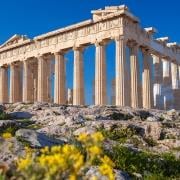
- Acropolis Hill
- Ancient Agora
- Acropolis Museum
- Temple of Olympian Zeus
- National Archaeological Museum
- Roman Agora
- Athens City Museum
- Athens Olympic Museum
- The National Garden
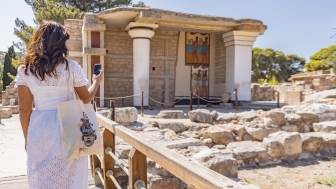
- Heraklion Archaeological Museum
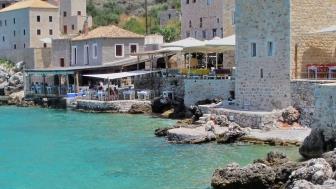
- Andritsaina
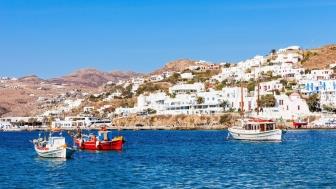
- Missolonghi
- Thermopylae
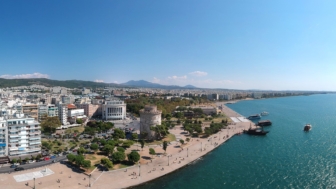
- Rhodes City Tours
- Grand Master Palace
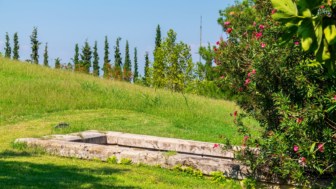
- The Colosseum
- The Roman Forum
- The Vatican City
- Castel Sant' Angelo
- Saint Peter's Basilica
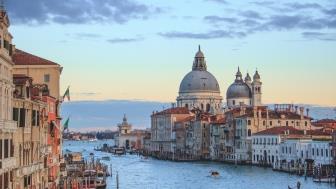
- Doge's Palace
- Saint Mark's Basilica

- Sempione Park
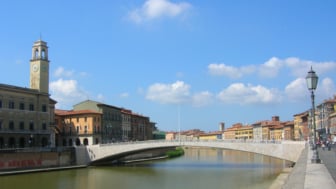
- The Tower of Pisa
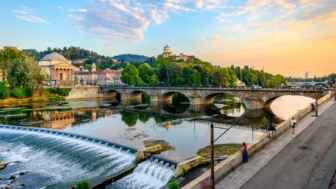
- The Red Light District
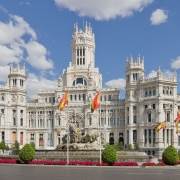
- The Alhambra Palace
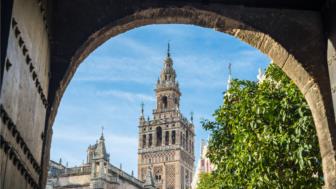
- Royal Alcazares
- The Seville Cathedral
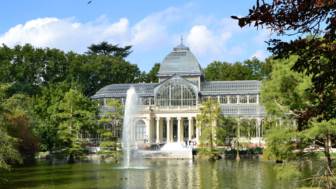
- Lázaro Galdiano Museum
- Archaeological Museum of Madrid
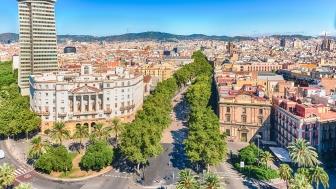
- Montjuïc Cable Car
- Mirador torre Glòries
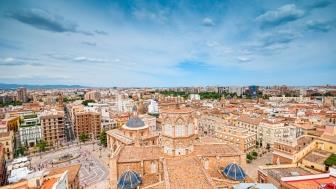
- The Mosque-Cathedral of Cordoba
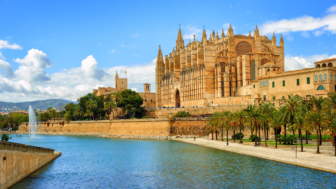
- The Mallorca Cathedral

- The Hagia Sophia
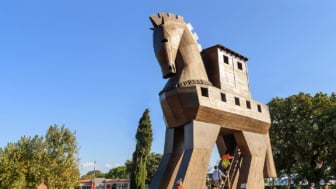
- Ephesus Ancient City Tour
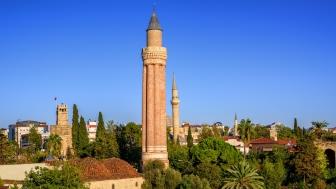
- Times Square
- Central Park
- Ellis Island & National Immigration Museum
- Niagara Falls
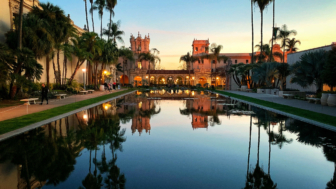
- Balboa Park

- Star Ferry Pier
- Victoria Peak
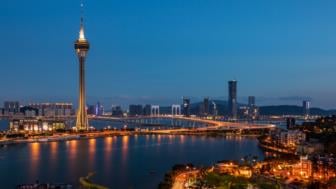
- Ruins of St. Paul
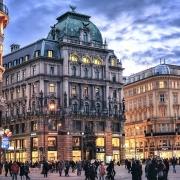
- Louvre Museum
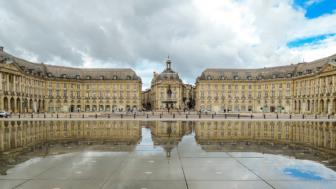
- Orange Roman Theatre & Museum
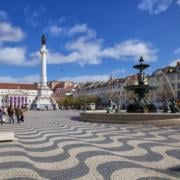
- St. George Castle
- Belem Tower
- Jerónimos Monastery
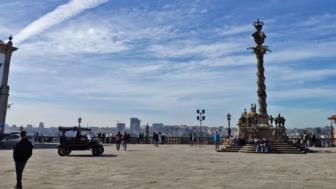
- Cathedral of Oporto
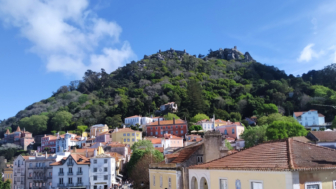
- Quinta da Regaleira
- The Pena Palace
- Moorish Castle
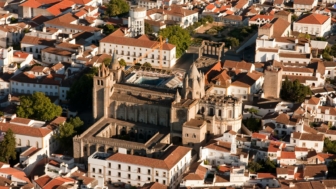
- Museu Nacional Frei Manuel do Cenáculo

- The Citadel of Qaitbay
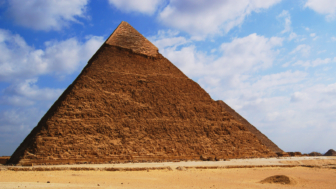
- The Hanging Church
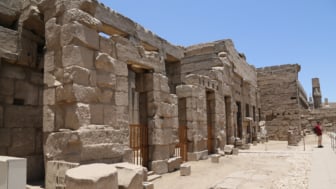
- Vajdahunyad Castle
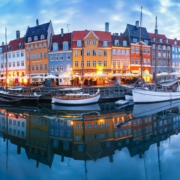
Inclusions and Exclusions
- The Location
Know before you book
Roman forum self-guided virtual experience: the beating heart of the empire.

€ 14,99 per person
- Important Information
Experience the Roman Forum from the comfort of your home with an engaging self-guided virtual tour, narrated in English from your PC or smartphone browser. It’s so simple! You will receive an email with the tour link with instructions and in a couple of minutes, you will travel back in time and enjoy a virtual journey from the comfort of your couch!
Through the power of storytelling combined with street and satellite views, you will learn not only about historical facts, but also discover unknown stories and tales of ancient and modern times that will amaze your family and friends. The tour’s content is the result of in-depth research, squeezed into brief intriguing stories that will make your virtual visit both engaging and informative. The tour is only available online and you can access it repeatedly and anytime.
This is an unmissable opportunity to gain valuable insights into the pulsating heart of Ancient Rome and immerse yourself in the surroundings in an entirely innovative way.
Too young to die
There is a heart-rending story of early loss lying behind the Basilica’s colonnade, probably known as "the Colonnade of Gaius and Lucius". Gaius and Lucius Caesar were the grandchildren of Augustus, the first Roman Emperor— Augustus adopted them both, and made them his heirs. Yet, they both died young, and so the imperial throne passed onto Tiberius. To celebrate their important status within Roman society, Augustus had two large inscriptions placed in the Basilica’s colonnade. One can still see the remains of the one dedicated to Lucius where his grandfather dubs him "Prince of youth".
- Virtual Self-guided Tour for the Roman Forum with satellite & street views
- Audio content with engaging & original stories in English
- Transportation
- Offline access
Mandatory items
- Desktop, laptop or smartphone device
- Internet connection
The location
Basilica Aemilia: You will learn everything about the Basilica Aemilia , the only Republican Basilica surviving today within the area of the Forum and listen to the heart-rending story of the grandsons of the first Emperor of Rome, “the princes of youth”. You’ll also take a good idea of the joyous lifestyle of the early Romans who, just like contemporary Italians, loved dining al fresco!
Via Sacra: Walking virtually along Via Sacra , the spine of the ancient city and setting of countless deeds and misdeeds, you’ll follow in the steps of the Roman warriors, who once returned victorious from their battles and conquests to march the route of the Roman Triumph. Some of the city’s most impressive attractions are lined on the road, including the imposing Arch of Titus.
The Temple of Caesar: Among many other fascinating attractions, you’ll encounter the famed Temple of Caesar, whose life and assassination are commemorated until today at the heart of the Forum. Leave a flower on the grave of the glorious general and learn about the games of power and control in the political life of Rome.
Important information
- This is a virtual tour for the Roman Forum that you can take from the comfort of your home and feel like you were there
- No live guide or meeting point required
- You will receive an email with instructions on how to access your tour via a link. Check your spam folder as well
- No special equipment is needed (i.e. special glasses). However, earphones or headphones are highly recommended to enjoy the experience.
- This product can be accessed from any web browser and requires internet connection
Cancellation Policy : This product cannot be refunded once activated.
A virtual audio tour is definitely value for money, as it allows you to experience the beauty of the Roman Forum and to listen to its exciting stories, without having to leave the comfort of your house or pay an entrance ticket to the sight. Totally recommend.

At first, I tried viewing the tour from my iPhone browser. That’s when I realised that the 360° feature wasn’t working properly. I was disappointed, but then tried a second time with my wife’s Android. It worked like a charm and it was a good experience. I just wish that the issue with the iPhone gets fixed soon.
Only logged in customers who have purchased this product may leave a review.
Other travelers also purchased
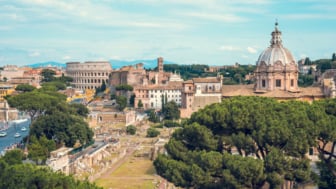
Castel Sant’ Angelo: E-ticket with Audio Tour and the Rome City Tour on Your Phone
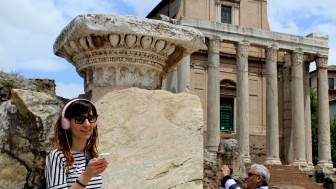
The Roman Forum: The Beating Heart Of The Empire
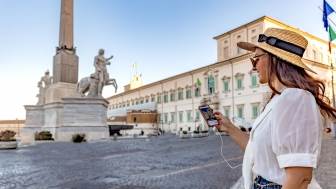
Rome city tour: Politics and Roman holidays
€ 9,99
Privacy Overview
Rome: Colosseum, Roman Forum & Palatine Hill Audio Tour
Italy, Rome

Book Your Tour
Self guided audio tour.
Free cancellation
Cancel up to 24 hours in advance for a full refund
Discover the Colosseum, Roman Forum & Palatine Hill with a Colosseum-guided audio tour. Our tour allows you to explore Rome’s most important and treasured historic sites, including a comprehensive Colosseum audio guide. The Colosseum is the largest amphitheater ever built since its construction in 70 AD and is undoubtedly one of the most recognized landmarks in the world. Uncover the events it used to host centuries ago, from gladiator fights to entertainment shows. Exploring the Colosseum is a truly immersive experience, made even more enriching with the help of a Colosseum audio tour or simply an expertly audio-guided Colosseum tours. At the Roman Forum, also known as the ‘Ancient City’, you will step back in time and discover the fascinating history of the Romans on a Roman Forum tour, as you observe ancient monuments, ruins, shrines, and temples. The entrance ticket to the Colosseum, Roman Forum, and Palatine Hill is not included and needs to be purchased separately. With this app-based self-guided audio tour of the Colosseum, Roman Forum & Palatine Hill, you will enjoy unlimited independent sightseeing of Colosseum, Roman Forum, and Palatine Hill with the convenience of a Colosseum audio guide. There's no need to meet up with a member of staff; simply download our App and start your experience straight away anywhere. Please note this is not the audio guide offered on the premises. This self-guided audio tour, is subject to the opening days and hours of the Colosseum, Roman Forum, and Palatine Hill. The entrance ticket needs to be purchased separately.
Inclusions & exclusions
What you get:
What you don’t get:
Discover the masterpieces of this venue, including:
Know before you go
How to use the Vox City App:
Please note, this is a digital experience. There is no meeting point or staff on-site.
Frequently Ask Questions
Do I need to find any guide if I have purchased a Colosseum, Roman Forum & Palatine Hill Self-Guided Audio Tour?
If the product you have purchased is a self-guided tour, as indicated in the title. Therefore, there is no designated meeting point, and there is no need to meet with someone from our team. You have the flexibility to enjoy the tour at your convenience.
How to download Colosseum, Roman Forum & Palatine Hill Self-Guided Audio Tour?
Simply scan the QR code on your voucher and follow the instructions to download the Vox City app and the city map in your preferred language. If you encounter any problems shoot us an email at [email protected] or contact our customer support live 24/7 through our website. Remember that you can download the city map prior to your arrival.
Do the entrance ticket comes with purchasing this audio guide?
This self-guided audio tour is subject to the opening days and hours of the Colosseum, Roman Forum, and Palatine Hill and the entrance ticket needs to be purchased separately.

Rated By Vox Citizens.
Overall rating
Review summary
The map was very helpful in guiding me around the city and making sure I didn't miss any important landmarks or attractions. Overall, I had a wonderful experience.
Amazing experience! The map was easy to follow and helped me navigate around the city without getting lost. Loved the thing that I can spend as much time as I wanted at each attraction.
Tour was well-designed and provided a lot of information about the history and culture. The colosseum audio guide commentary was also very good and kept me engaged throughout the tour.
The audio tour for the Colosseum is both informative and user-friendly, providing a personalized guide to reveal the mysteries of this remarkable ancient wonder.
The audio tour of the Colosseum was a game-changer, offering an abundance of information that didn't overwhelm me and enhanced my overall experience.
A great way to explore the city on my own. The Colosseum audio guide was well-organized. Appreciate the fact that I could choose which landmarks and attractions to visit based on my own interests.
The Colosseum audio guide was well-structured, offering detailed explanations of the historical and architectural significance of each site. It was like having a knowledgeable guide with me throughout my visit.
I recently explored the Colosseum, Roman Forum, and Palatine Hill with the self-guided audio tour from Vox City, and it exceeded my expectations. The Colosseum audio guide provided insightful commentary, taking me on a journey through ancient Rome's history and bringing the ruins to life.
The self-guided audio tour of the Colosseum, Roman Forum, and Palatine Hill from Vox City was an absolute delight. The Colosseum audio guide was informative and easy to follow, providing a wealth of historical context and interesting facts about each site. It was a fantastic way to explore these ancient landmarks at my own pace, without feeling rushed.
As a solo traveler, the Colosseum Audio Tour was a perfect companion. It allowed me to explore at my own pace while still learning about the incredible history of the Colosseum. The quality of the audio and the content exceeded my expectations.
I'm not usually a fan of audio tours, but the Colosseum Audio Tour completely changed my perspective. The narration was clear, and the historical anecdotes were both interesting and entertaining. It added a whole new layer to my visit.
I had an incredible experience with the Colosseum Audio Tour! The audio guide was informative and engaging, providing fascinating insights into the history of this iconic monument.
The Colosseum Audio Tour was like having a knowledgeable friend guiding me through the ancient ruins.
The Colosseum Audio Tour is a gem! It not only provided historical insights but also highlighted interesting architectural details that I might have overlooked.
The Colosseum Audio Tour is a must-download before visiting. It not only educated me about the history but also pointed out architectural details that I might have missed otherwise.
My visit to the Colosseum was transformed by the audio tour, which proved revolutionary. The narrations were articulate and precise, providing historical insights that entirely enveloped me in the experience.
The audio tour is an essential experience for anyone visiting the Colosseum. It provided detailed insights that greatly improved my comprehension of this historic site.
I advocate for the Colosseum audio tour. It feels as though you have your own private guide, enhancing the experience by offering captivating insights.
During my exploration of the Colosseum, the audio tour served as a wonderful companion. It not only guided me but also enriched my knowledge about its opulent history.
The audio tour of the Colosseum is a real treasure. Providing crystal clear sound, captivating pieces of information and freedom to explore at your preferred speed- it's an impeccable fusion of technology with history.
Although I've visited the Colosseum previously, utilizing an audio tour enriched my admiration to a new level. It felt like experiencing its magnificence all over again!
History enthusiasts shouldn't miss the Colosseum audio tour, which brought the ancient amphitheater to life with enthralling storytelling.
The audio tour was an incredible investment as it spared me from reading guidebooks and granted a more profound comprehension of the Colosseum.
Exploring the Colosseum with an audio tour allows for a personalized pace and is a superb method. The narration provided is captivating, which resulted in a greater sense of connection to its history.
For independent travelers, this audio tour is a game-changer as it provided me with an educational and enjoyable experience during my visit to Colosseum. It allowed the freedom to explore on my own terms.
The audio tour of The Colosseum felt like having a well-informed companion accompanying me, providing greater insight into its history and facilitating my understanding of it.
The Colosseum audio tour enhanced my visit and elevated my appreciation for its magnificence with clear, concise narration that captured me.
I highly recommend the Colosseum audio tour. It turned my trip into an immersive experience, taking me on a historical journey that taught me numerous intriguing facts about its past.
An incredible approach to exploring the Colosseum! The audio guide furnished an abundance of knowledge, contributing to a fascinating and informative trip.
Though skeptical of audio tours initially, my expectations for the Colosseum experience were surpassed with fantastic narratives that enhanced its depth and kept me engaged.
The Colosseum audio tour's flexibility was highly appreciated by me as it granted the liberty to explore every intricate aspect at my own comfortable pace, rendering the entire visit more delightful.
Families can greatly benefit from the Colosseum audio tour, as it effectively captures one's attention with its informative and captivating narrations, making it an excellent companion for my kids.
Experiencing the Colosseum through its audio tour is an exceptional means of assimilating history without any haste. The narrations provided are lucid, and it brings about a profound quality to the entire visit.
For someone who loves history, the audio tour of the Colosseum was a dream that came true since it offered plentiful narrations imparting valuable knowledge and enriching my comprehension regarding its importance.
The audio tour makes for an excellent partner in a self-directed exploration of the Colosseum.
For those seeking a comprehensive comprehension of its history, the Colosseum audio tour is essential.
If you’re in Rome, taking the audio tour of The Colosseum is highly recommended. It transforms an average trip into a fascinating and unforgettable voyage through time with its educational insights on history.
My visit to the Colosseum was highlighted by the audio tour.
Although I've been to the Colosseum several times, using an audio tour enhanced my comprehension in a way that was previously absent. It is essential for anyone visiting for the first time or returning.
For those visiting the Colosseum for the first time, the audio tour is an ideal companion. It provides valuable information in a user-friendly manner and enhances one's overall visit to this historic site.
Investing in the Colosseum audio tour is truly valuable as its captivating narrations readily immerse you into history and offer an excellent opportunity to explore at your leisure.
My visit to the Colosseum became an educational escapade, thanks to the audio tour. It's enlightening, captivating and a remarkable method for maximizing your experience at this world-renowned destination.
I'm delighted that I chose the Colosseum audio tour. It amplified my experience and gave me a sense of having a personal guide detailing its captivating past.
Discover More Experiences

St. Peter's Basilica & Dome Entry Ticket Audio Guided Tour
- St. Peter's Basilica
- Sistine Chapel
- Vatican Gardens & More

Rome: Trastevere & Jewish Ghetto Self Guided Tour
- Turtle Fountains
- Tiber Island
- Portico of Octavia & More

Castel Sant'Angelo Self Guided Audio Tour
- Hall of Urns
- Diametral Ramp
- Dromos & More

The Green Lung of Rome Self Guided Tour
- Piazza del Popolo
- Villa Borghese
- Pincian gate & More

Rome: Skip the line Pantheon ticket + Audioguide
- The Rotonda
- The Eminent Tombs
- The Dome & more…

Explore Rome: Self-Guided Tour Discovery Pack - Top Rated
- Pantheon & more..
The World At Your Fingertips.
Experience what it's like to Discover the world with the Vox City App.

Exclusive discounts and travel inspiration
Weekly in your inbox, daily in your feed

Explore the World

IMAGES
VIDEO
COMMENTS
One of my favorite places is the Roman Forum and Palatine Hill. The map of attractions is HERE and the self guided walking tour is HERE. Self Guided Walking Tours - Day Trips from Rome. Visit Pompeii with a complete self guided tour map HERE and the attractions guide to the 49 points of interest HERE. Spend the day in Florence, this was by ...
Use the Palatine Hill & Roman Forum map & this self guided tour to visit the ruins. There are over 25 popular attractions; you can also download the google map of the ruins and use it offline as your self guided tour. It's a good idea to do some planning before visiting the ruins because if you put yourself at the mercy of the tour guide, you ...
Roman Forum Walking Tour with Map. This post is a self-guided tour of the Forum in Rome as well as the adjacent Imperial Fori. The tour should take approximately 1 hour or just a bit less than that. The walk is approximately 1 km (just over 1/2 a mile). This walk is an abridged version of our Ancient Rome audio tour.
How to visit the Roman forum: guided tour or self guided? 2021 Update. The Roman Forum is a place so full of history and thing to see it is best enjoyed with a guide. The area has almost non existent info panels so without some form of guidance, you can enjoy its beauty but you won't understand much.
The long lines to enter the Colosseum and Roman Forum can dramatically cut into your sightseeing schedule. Save hours with fast-track access on this self-guided tour, choosing the time that best fits your itinerary to visit the ancient amphitheater, forum, and Palatine Hill archaeological site. Once inside, linger as long as you like to take in ...
The Roman Forum. The Roman Forum: The Beating Heart Of The Empire. Audio Tours. 3.7/5(3) $ 12,82 per person. Self-guided audio tour. Follow the story at your own pace. English, Deutsch, Español, Italiano. For both audio and stories included.
Embark on the riveting self-guided audio tour of the Roman Forum and Palatine Hill, a 1.5-hour immersive experience that delves into the rich history of the ancient Roman Empire. This tour offers visitors the flexibility of self-paced exploration, allowing them to linger at stops that pique their interest. The audio guide provides fascinating ...
4. Rome: Colosseum, Palatine Hill and Roman Forum Guided Tour. Explore the most famous amphitheater in the world on this guided tour. Enter the Colosseum with skip-the-line tickets and learn its incredible history. With your guide, walk on Palatine Hill and through the Roman Forum to see the most iconic monuments of Ancient Rome.
Set out on a digital journey through the heart of ancient Rome with the Roman Forum's innovative self-guided audio tour. As visitors stroll past the remnants
PLEASE NOTE: This is a self-guided audio tour, not an entry ticket to the Roman Forum. Roman Forum tickets must be purchased separately. Guided tours can be relatively expensive and often follow rigid itineraries and tight schedules. This self-guided audio tour of the Roman Forum allows travelers to save money and explore at their own pace. See the Forum while listening to stories about the ...
This map was created by a user. Learn how to create your own.
Self-guided walking tour: Roman Forum and Imperial Forums Walking Tour in Rome, Italy. The detailed walk route map can be downloaded to your mobile device for turn-by-turn travel directions. ... Guide Type: Self-guided Walking Tour (Sightseeing) # of Attractions: 20 Tour Duration: 3 Hour(s) Travel Distance: 2.6 Km or 1.6 Miles
This is a self-guided audio tour that you can start, pause, or restart at any time and complete at your own pace. See address & details. 1. Roman Forum. Stop: 60 minutes - Admission excluded. The tour takes you on an ordered walk beginning at the Temple of Antoninus and Faustina and ending at the marvelous Arch of Titus, through which you can ...
4,295. Avoid the long entrance lines at the Colosseum, Roman Forum, and Palatine Hill during this skip-the-line tour of the sights in ancient Rome. With a guide, head into the Colosseum to walk in the footsteps of gladiators, emperors, and plebeians as tales of the brutal games ring in your ears.
1h 10min. 64stories. 14stops. Experience the Roman Forum from the comfort of your home with an engaging self-guided virtual tour, narrated in English from your PC or smartphone browser. It's so simple! You will receive an email with the tour link with instructions and in a couple of minutes, you will travel back in time and enjoy a virtual ...
Avoid the long entrance lines at the Colosseum, Roman Forum, and Palatine Hill during this skip-the-line tour of the sights in ancient Rome. With a guide, head into the Colosseum to walk in the footsteps of gladiators, emperors, and plebeians as tales of the brutal games ring in your ears. Stroll amid the ruins of the Roman Forum, then discover layers of Roman history on Palatine Hill.
The self-guided audio tour of the Colosseum, Roman Forum, and Palatine Hill from Vox City was an absolute delight. The Colosseum audio guide was informative and easy to follow, providing a wealth of historical context and interesting facts about each site.
To ensure you have a seamless and immersive experience at the Roman Forum, let's dive into the inclusions and requirements of the tour. The tour experience includes a highly acclaimed self-guided audio tour with historian Michael Anderson, allowing you to explore the Roman Forum at your own pace. The tour is available in English and has a duration of 45 minutes.
Travel back in time and immerse yourself in the life of Roman gladiators. Marvel at the views of Rome from atop the Palatine Hill. A small-group, more personal experience with your tour guide. Uncover the mysteries of the Colosseum from your expert guide. Channel your inner Senator in the heart of the Roman Forum.
Rome: Colosseum, Roman Forum & Palatine Hill Audio Tour. Italy, Rome. 5.0(44 reviews) Show More (8) Discover the Colosseum audio guide, Roman Forum & Palatine Hill with a self-guided audio tour. Explore at your own pace and enjoy storytelling from our multilingual audio guide as you go.